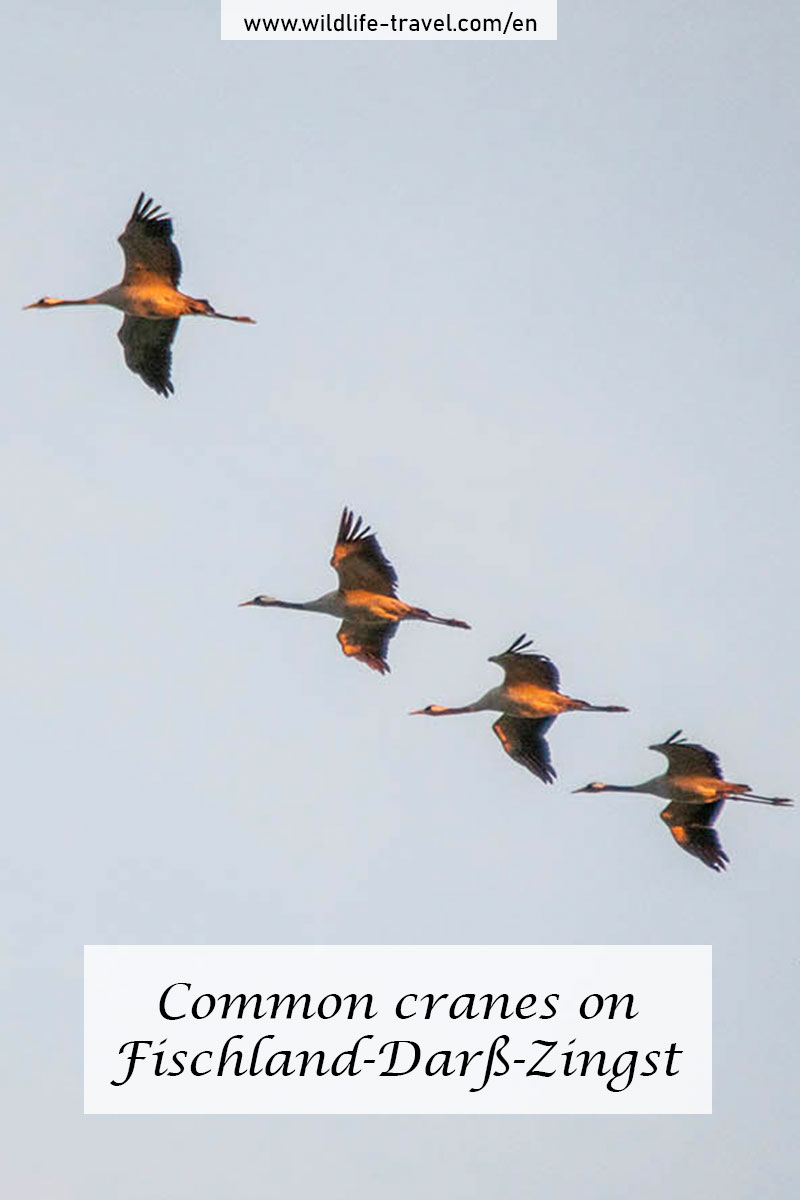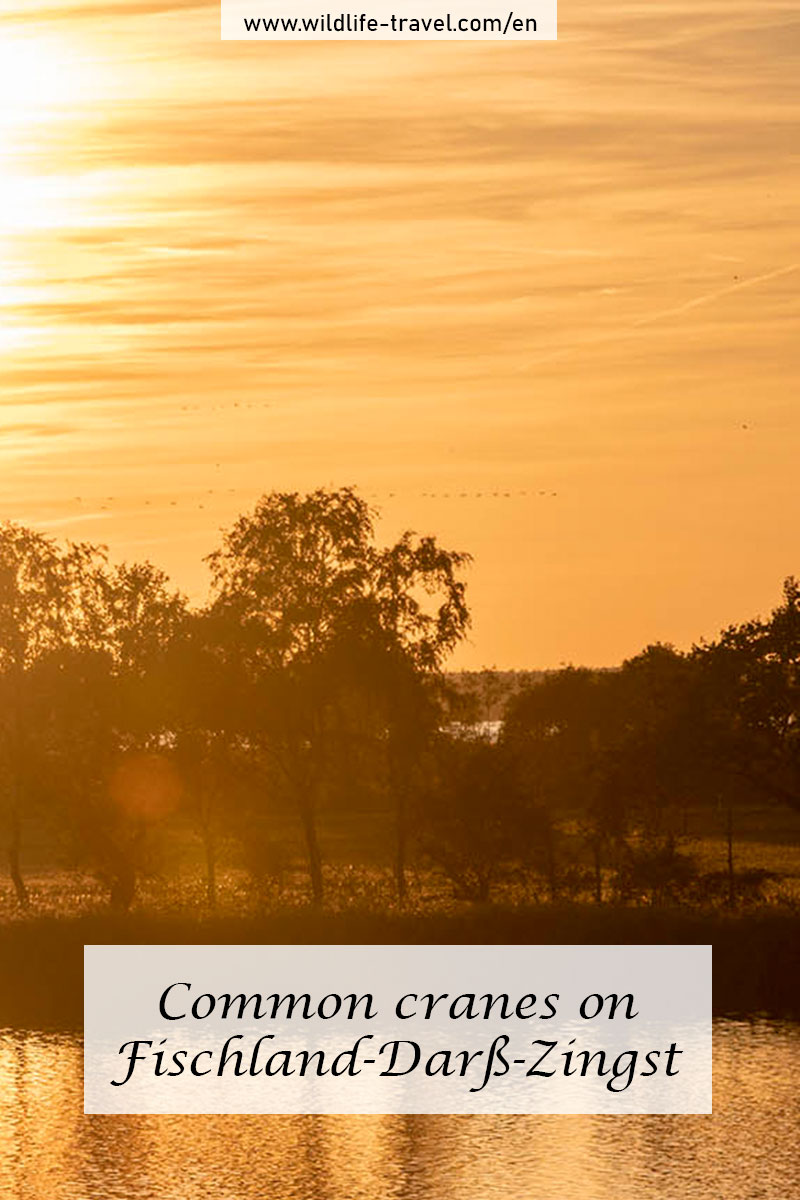Fischland-Darß-Zingst is a peninsula in the north of Germany and a very popular place for holidaymakers. The peninsula is also very popular among birders as in autumn thousands of cranes gather together on their migration on Fischland-Darß-Zingst. As I have visited the peninsula in one October, I will tell you more here in this blog entry about the crane migration at the Baltic Sea and what you can expect during a crane watching boat trip in Zingst.
Fischland-Darß-Zingst
Our bus from Berlin arrived early in Zingst.
We still had plenty of time on that day to check in in the Youth Hostel in Zingst, rent a bike and get to know a little bit the area around Zingst.
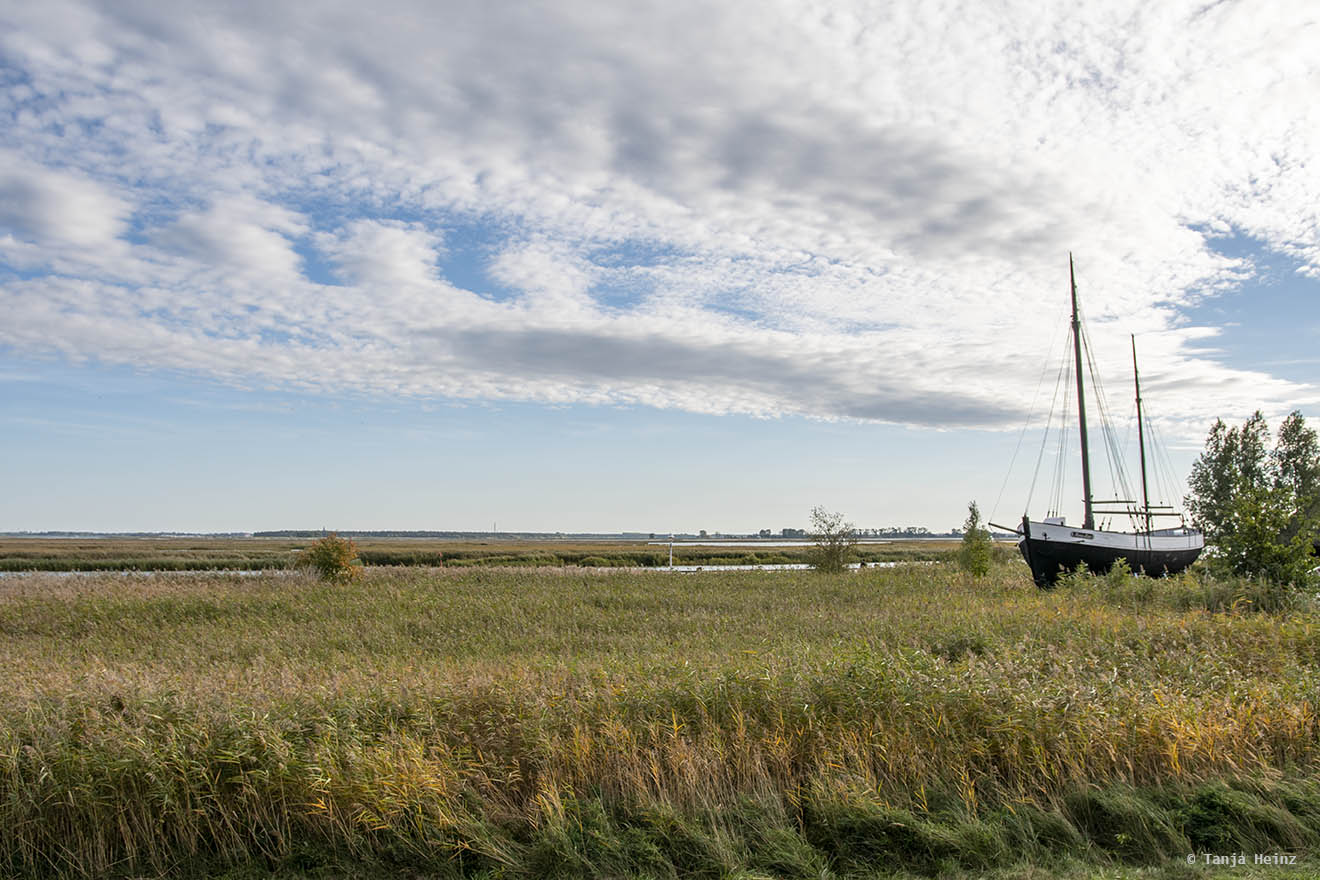
It is not difficult to get around and get to know the village.
Zingst is very small with a total population of only about 3000 people.
Zingst is one of the six villages on Fischland-Darß-Zingst. It is located in the center of the peninsula and within easy reach by bus (if you do not want to use your own car to get to Fischland-Darß-Zingst).
Nevertheless, we went to Fischland-Darß-Zingst for one reason.
We wanted to become witness of one of the most incredible natural spectacles Germany has to offer.
The yearly migration of thousands of cranes (Grus grus).
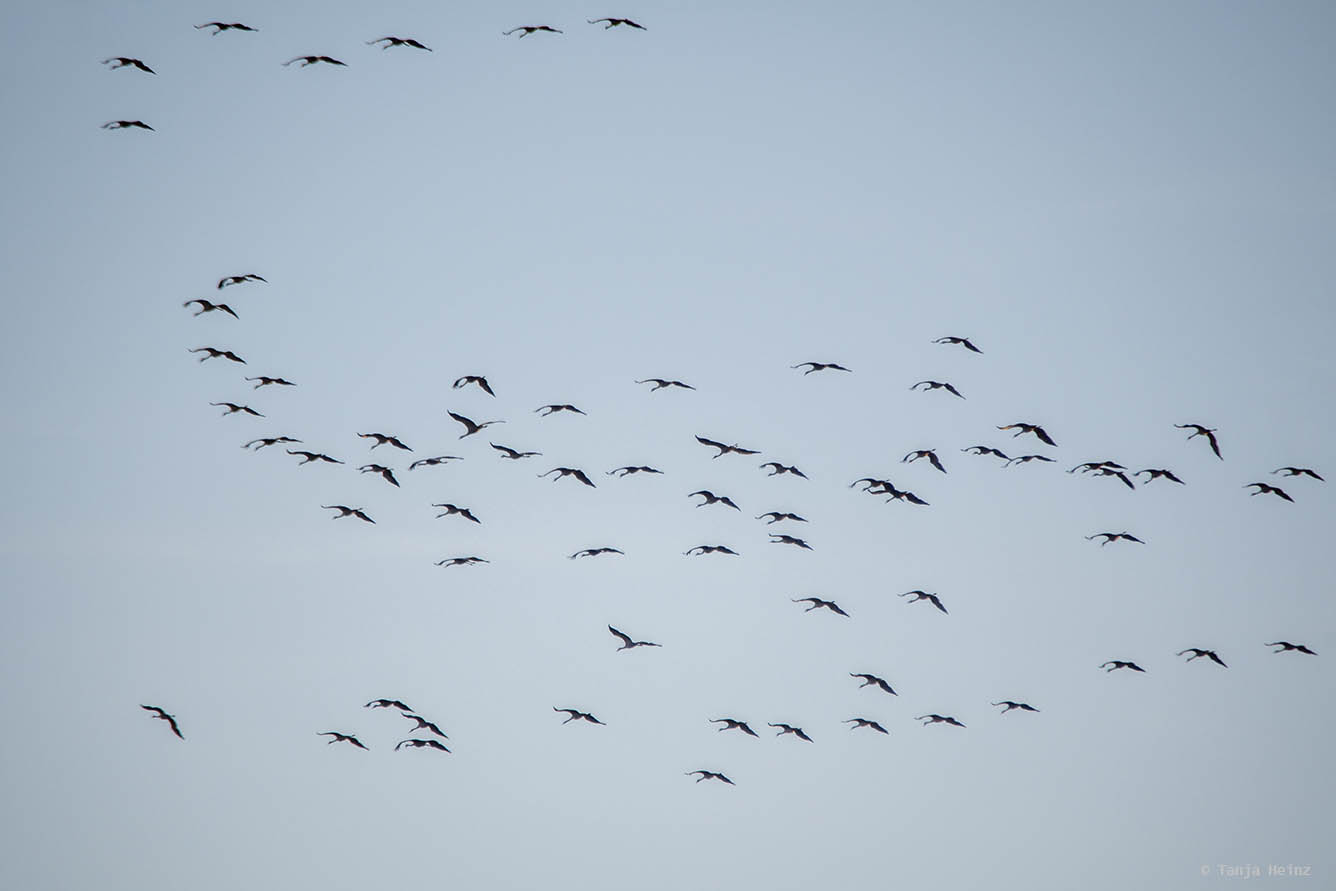
And Zingst is one of the best starting points to do that on Fischland-Darß-Zingst.
However, before I tell you more about my experiences with crane observations on Fischland-Darß-Zingst, I want to give you some more information about the geographical location.
Fischland-Darß-Zingst is a long peninsula and located in the north of Germany in the state Mecklenburg-Western Pomerania. Most of the area of Fischland-Darß-Zingst belongs to the Western Pomerania Lagoon Area National Park (German: "Nationalpark Vorpommersche Boddenlandschaft").
The national park is characterized by the bodden. The bodden area is a shallow body of water forming lagoons along the coast. The Bodden is very typical for the southern Baltic Sea.
Did you know? The Western Pomerania lagoon Area National Park is the largest national park in Mecklenburg-Western Pomerania and the third largest in Germany. With an area of more than 750 square kilometers the national park comprises several peninsulas, islands and lagoons including Fischland-Darß-Zingst, but also, for example, the western coast of Rügen, Hiddensee or Ummanz.
The Darß-Zingst Bodden Chain can be divided from West to East into the Saaler Bodden, Bodstedter Bodden, Barther Bodden and Grabow.
Zingst is located at the Barther Bodden with the Bodden islands Große Kirr and Oie close-by.
These two islands are especially interesting in autumn if you want to observe cranes close to Zingst as these two islands are important roosting sites for cranes on Fischland-Darß-Zingst.
In Zingst you can find several companies that offer boat tours to watch cranes around the island Große Kirr.
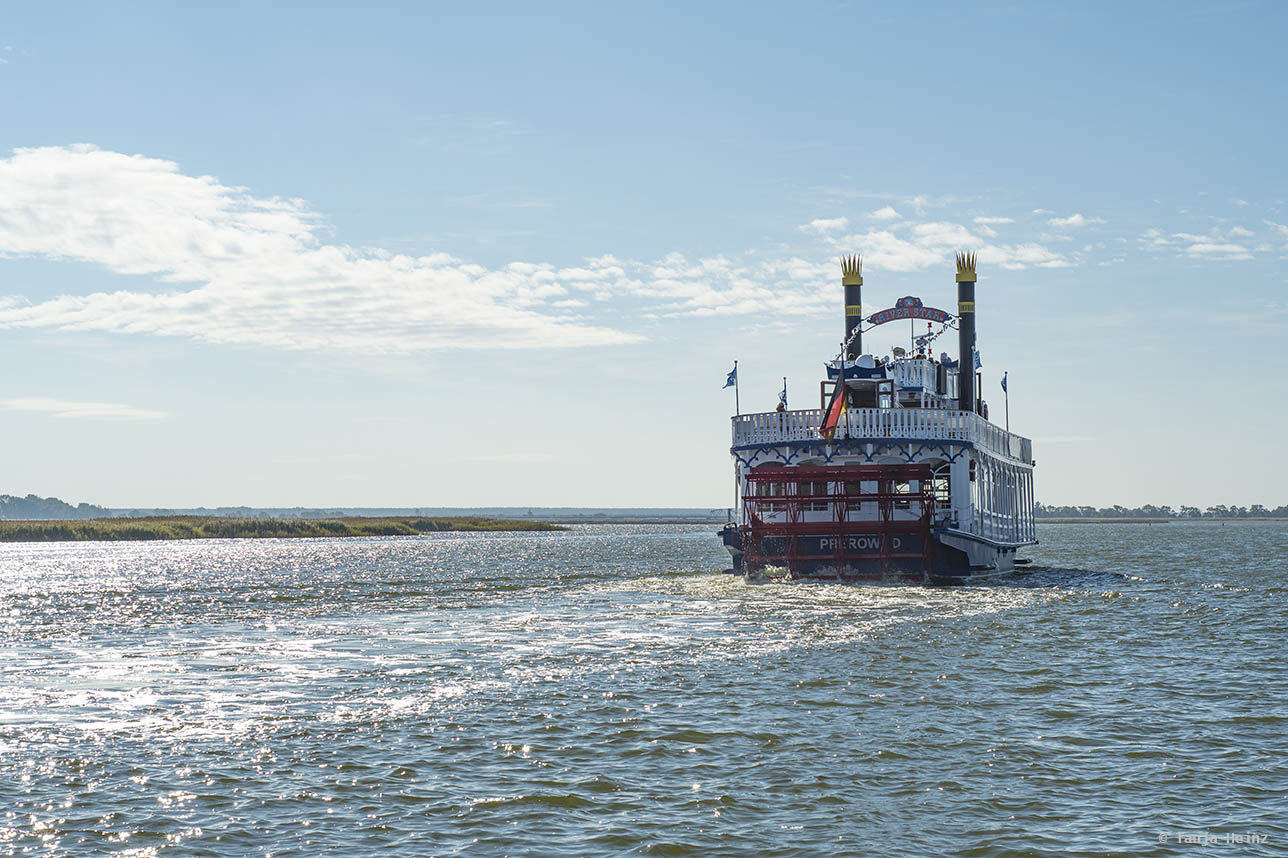
We participated in one of these boat tours.
Crane observations by boat
Cranes are a symbol of luck and I’m sure they leave many nature observers with a feeling of happiness.
At least it was like that in my case.
It is difficult to describe the moments I had on that boat in the middle of the bodden on Fischland-Darß-Zingst when thousands of cranes were flying over us to their roosting sites.
I was in awe.
I was so thrilled.
And I felt so much luck.
Nevertheless, all this started at the harbor in Zingst from where boats leave to watch common cranes in their natural habitat.
We chose to book a crane watching tour with the MS River Star of the company Poschke.
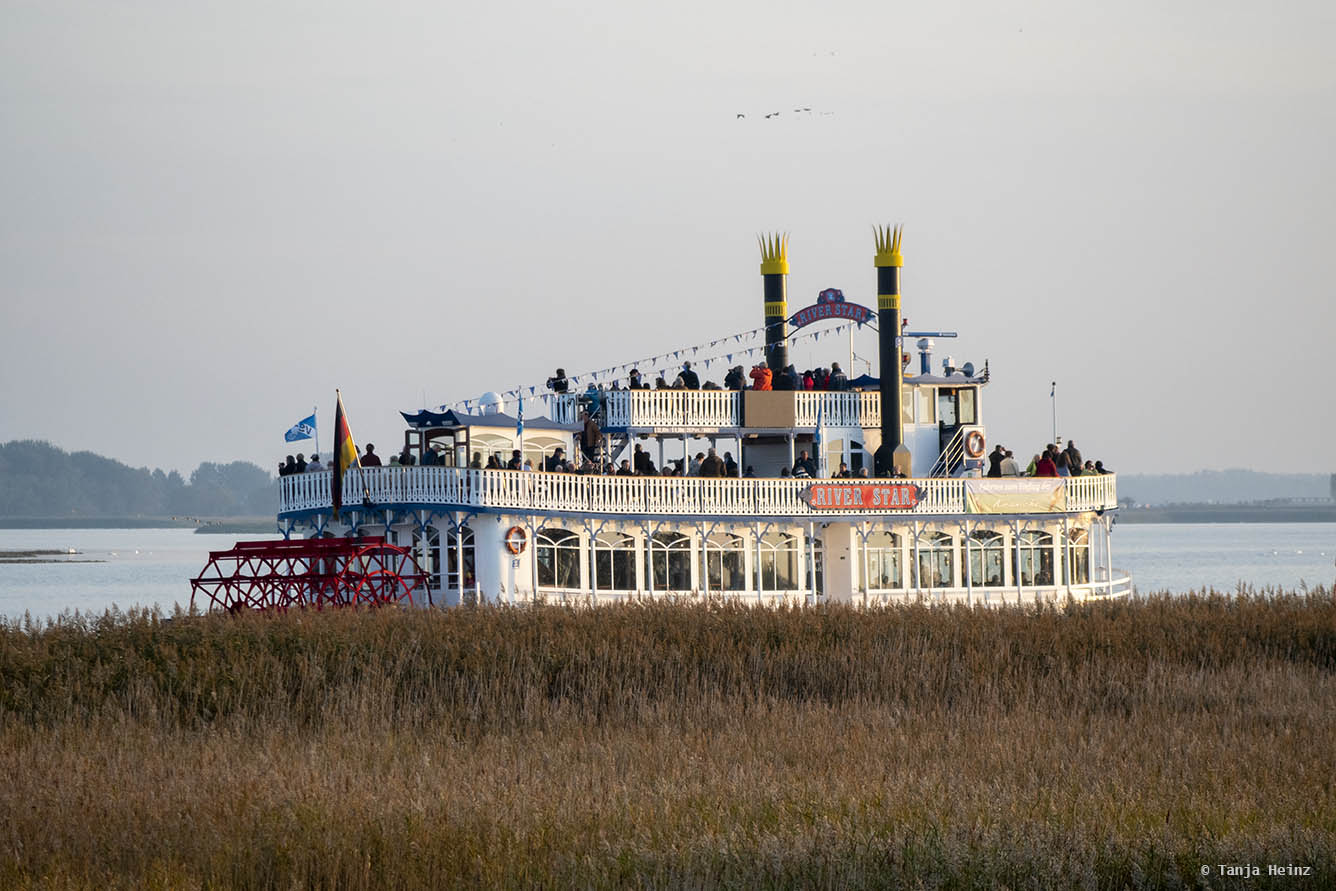
The tour usually takes about two hours. However, on the day we participated in the crane watching tour, it took definitely more than two hours.
I haven’t checked my watch.
But I would guess it was about three hours. Maybe because it was such a wonderful day?
Tip: Bear in mind that the boats leave at different times in September, October or November. Please check the websites of the companies for more information about departure times. You will find more information about the MS River Star below in the paragraph "Practical information".
At the beginning of the tour we got to know a little bit the area around the Barther Bodden and the island Große Kirr.
We could even see the town Barth from afar.

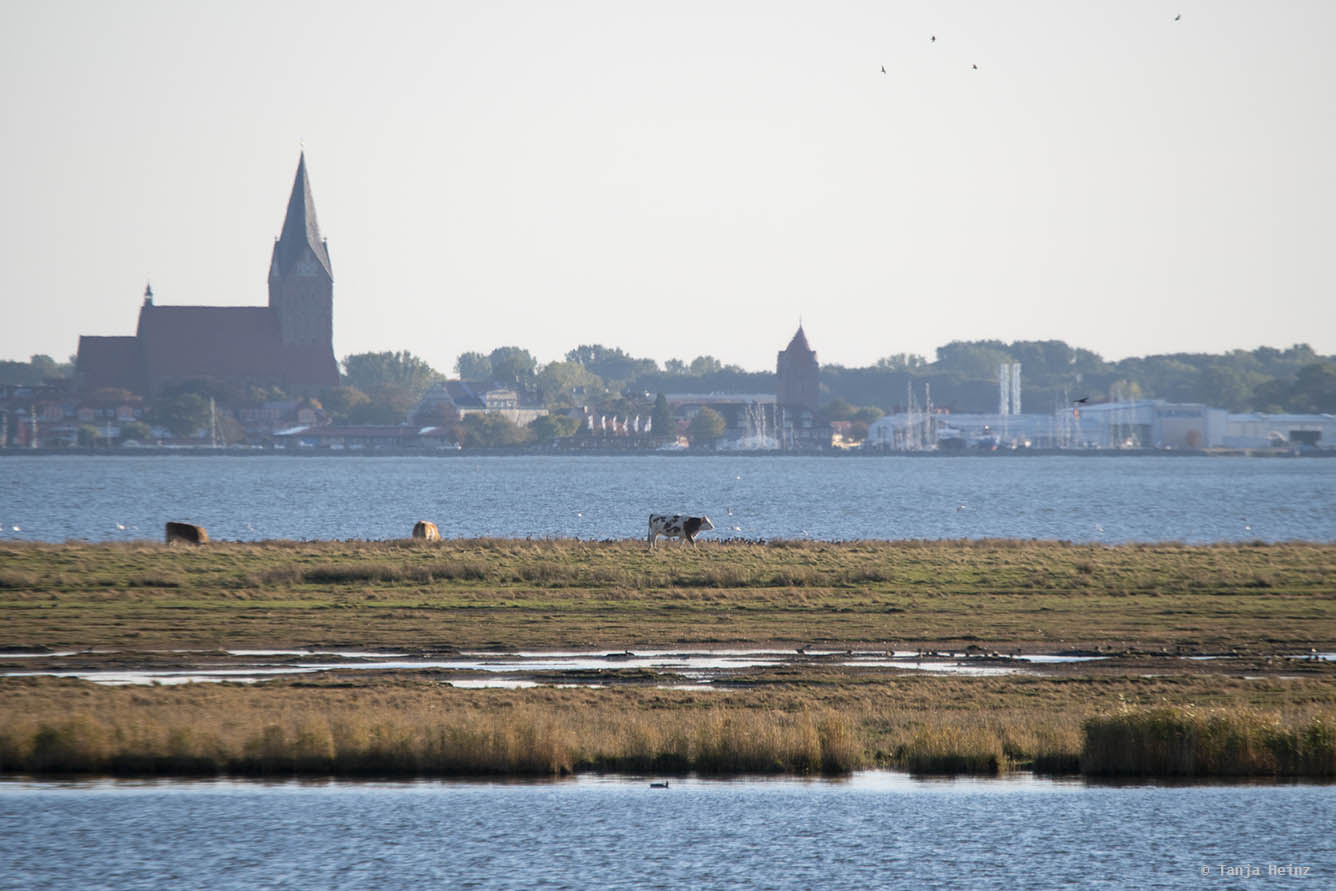
We learned more about the region and other wildlife that lives in the bodden (see below) through a guide that spoke via a loudspeaker.
It was cold, but the light on that day was wonderful.

Although it was not the first time for me to watch common cranes in their natural habitat, I was with a thrill of anticipation.
When would the cranes fly in?
Although it was still daylight, from afar we could already observe some cranes roosting on the island Große Kirr.
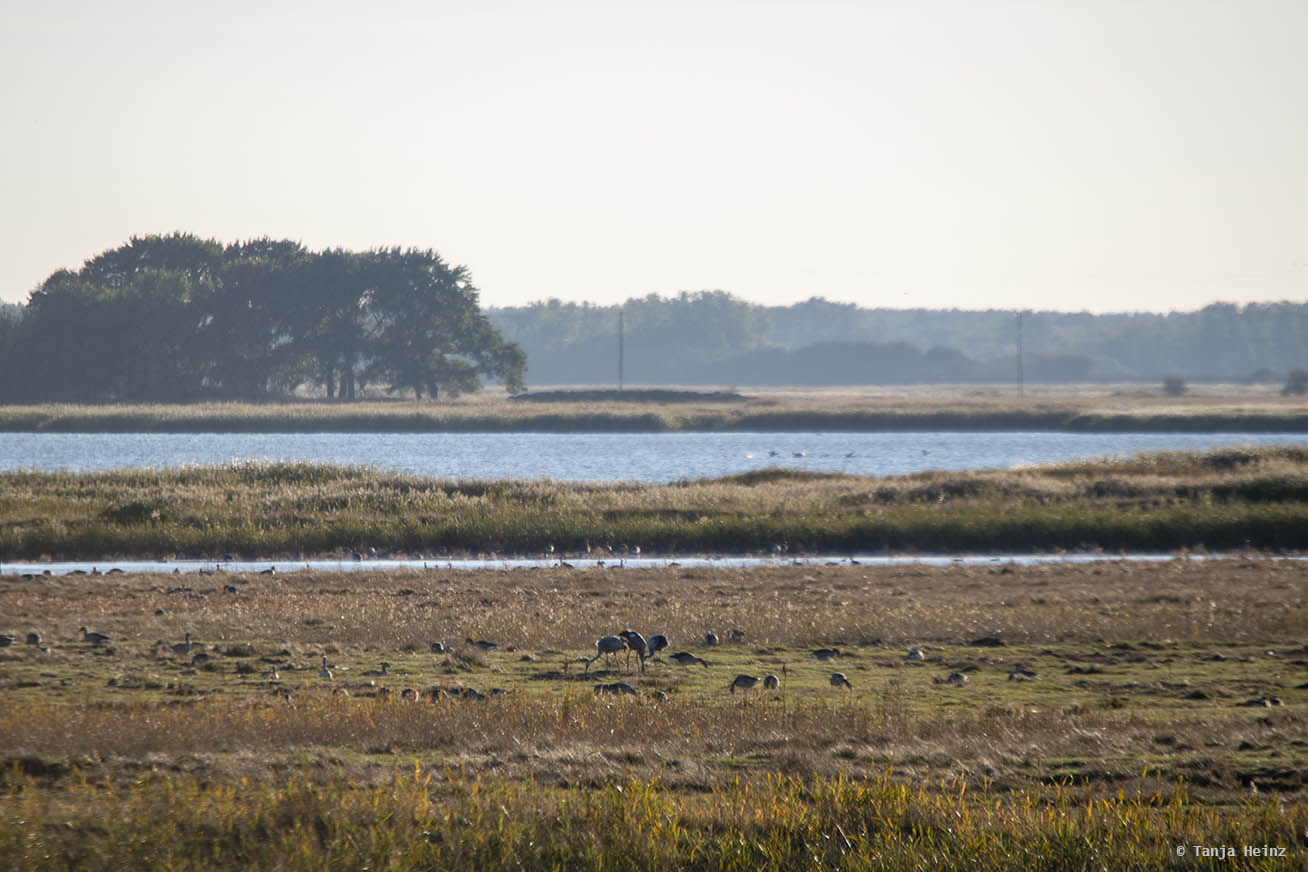
But the most interesting part of our crane observation tour still lay ahead of us.
In the meantime, I was looking for other interesting things in the area.
On one side we saw some cyclists on land from afar.
On the other side we spotted many (many!) mute swans.
I had never seen so many mute swans in one spot. Blacks swans yes, in Australia. But mute swans?
No, but it was wonderful.
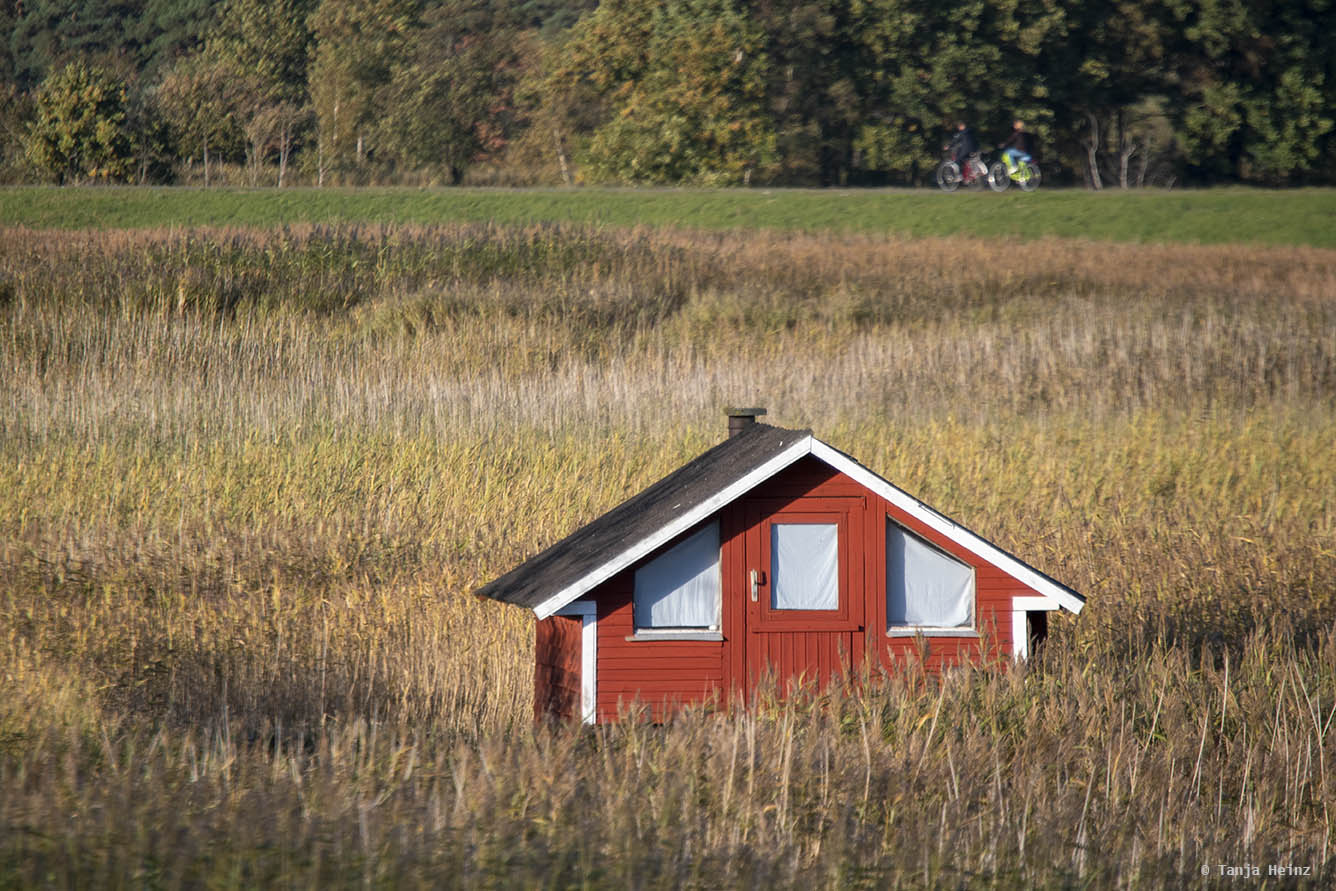

Another boat close-by passed the MS River Star.

Probably I wouldn’t have seen the boat if the cranes would have been already flying in.
I couldn’t hardly wait for the cranes to arrive.
And there.
Finally.
From afar we could hear their loud trumpeting calls.
After a long day searching for food in the fields of Mecklenburg-Western Pomerania, finally large flocks of common cranes fly in in their typical V-shaped formation to the island Große Kirr.
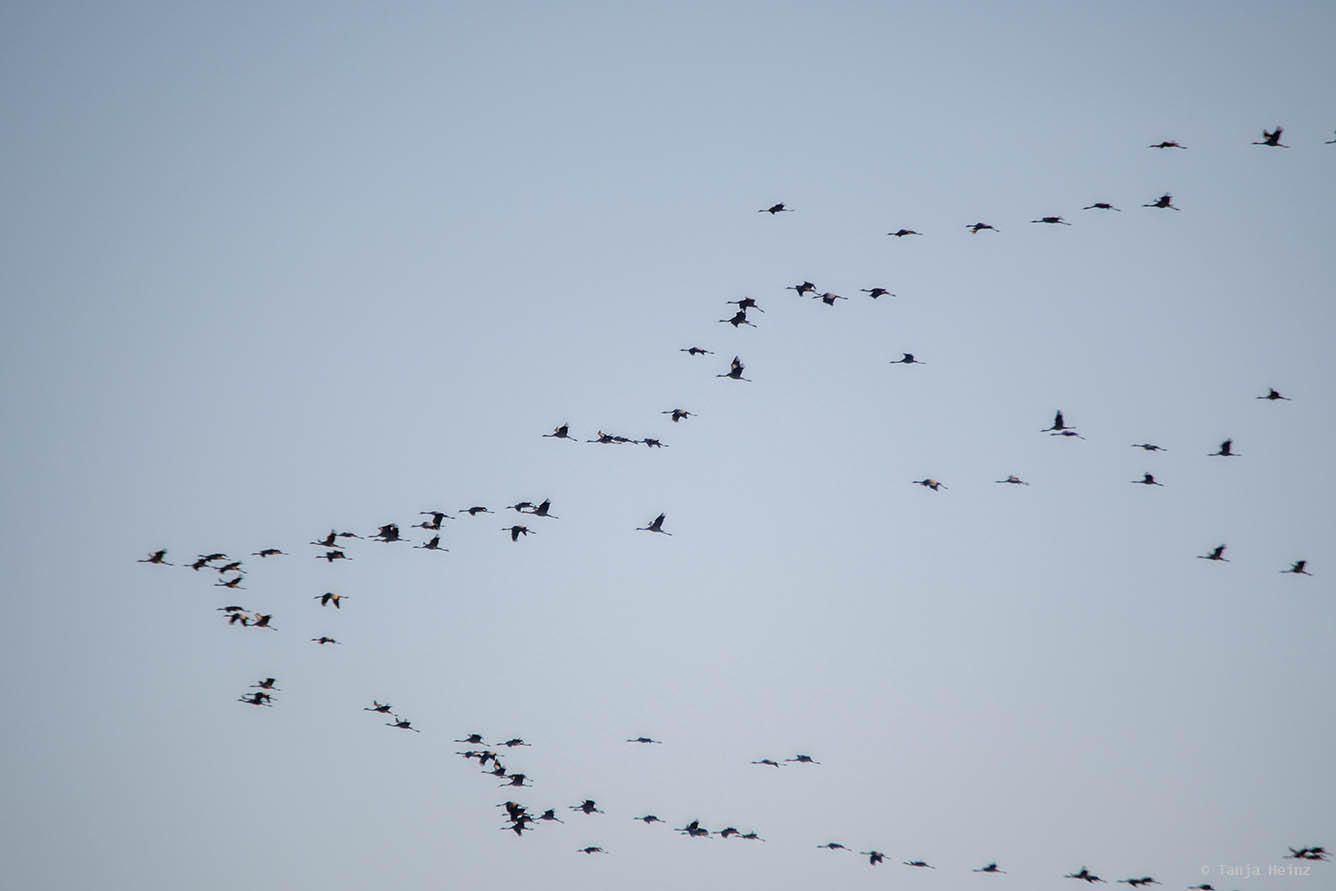
Just wow!
Interesting: Common cranes fly in a V-shaped formation to use aerodynamics and save energy. Birds at the beginning of the formation are the strongest birds with most experiences, as this position requires especially much energy.
Me and many other nature observers prepared our cameras to get some nice photographs of these wonderful birds.
However, this was not an easy task. As the birds were far away, it was necessary to have a good telephoto lens.
Nevertheless, the MS River Star was heading to the Meiningenbrücke which connects Fischland-Darß-Zingst with the mainland.
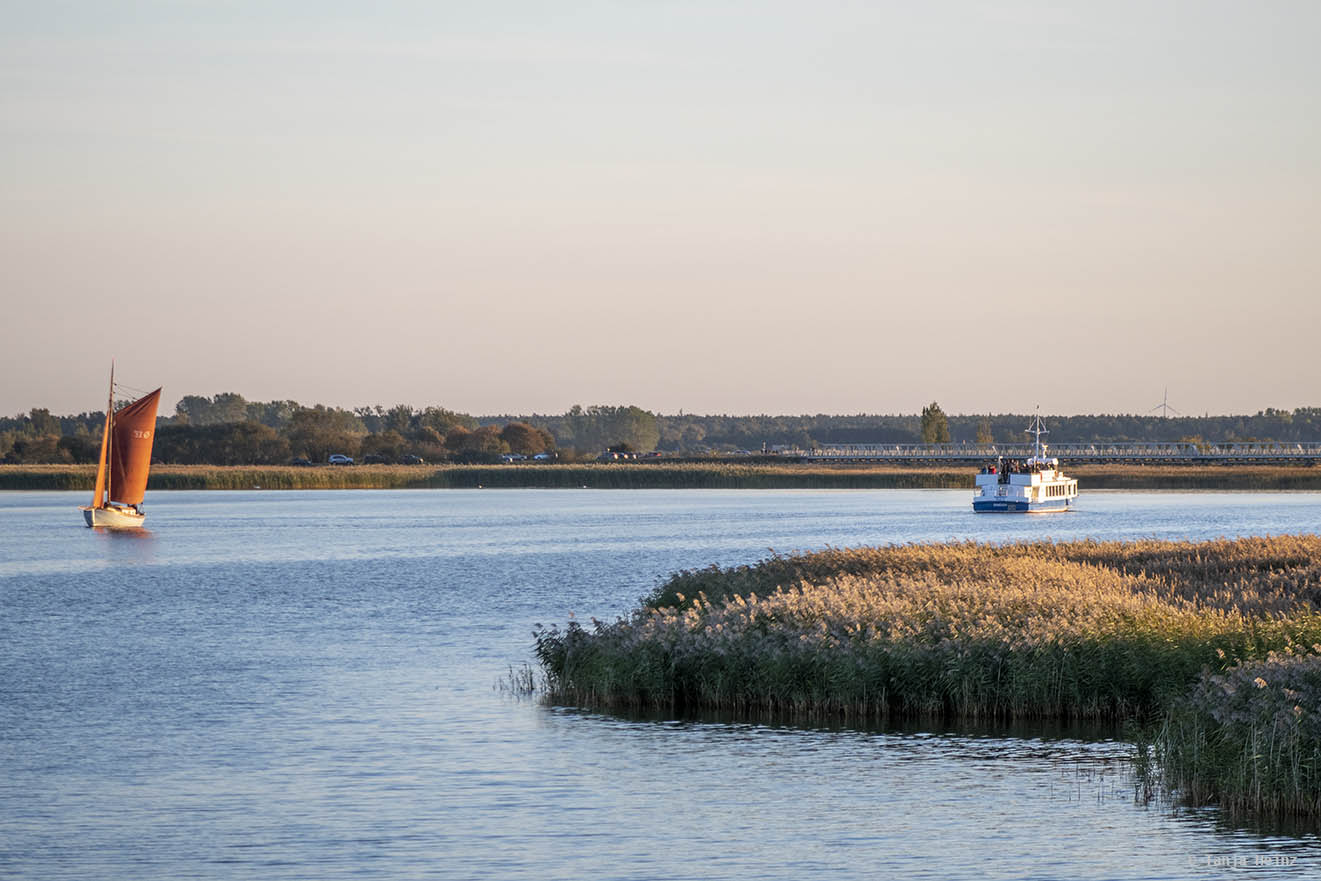
More and more common cranes were flying in from all sides.
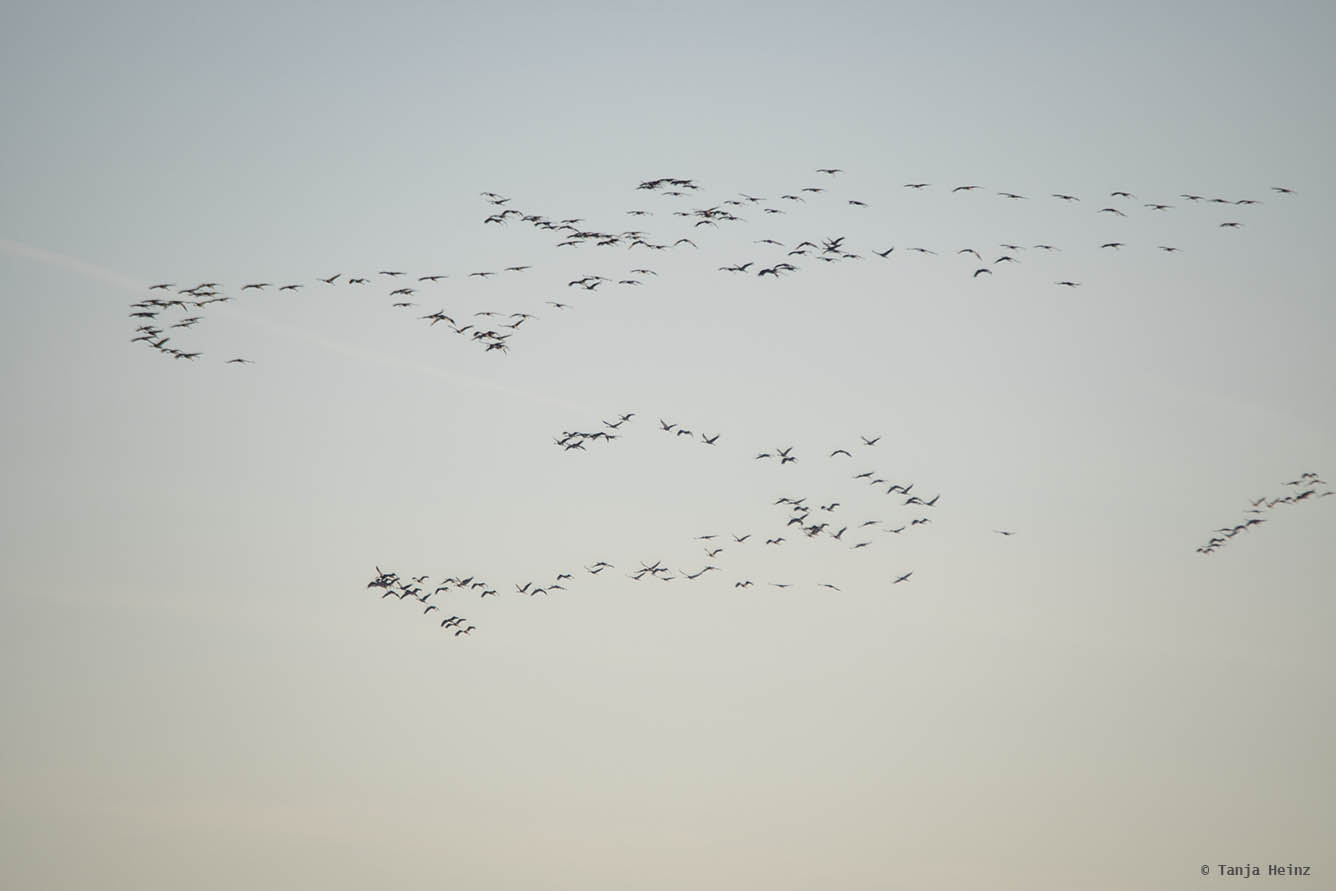
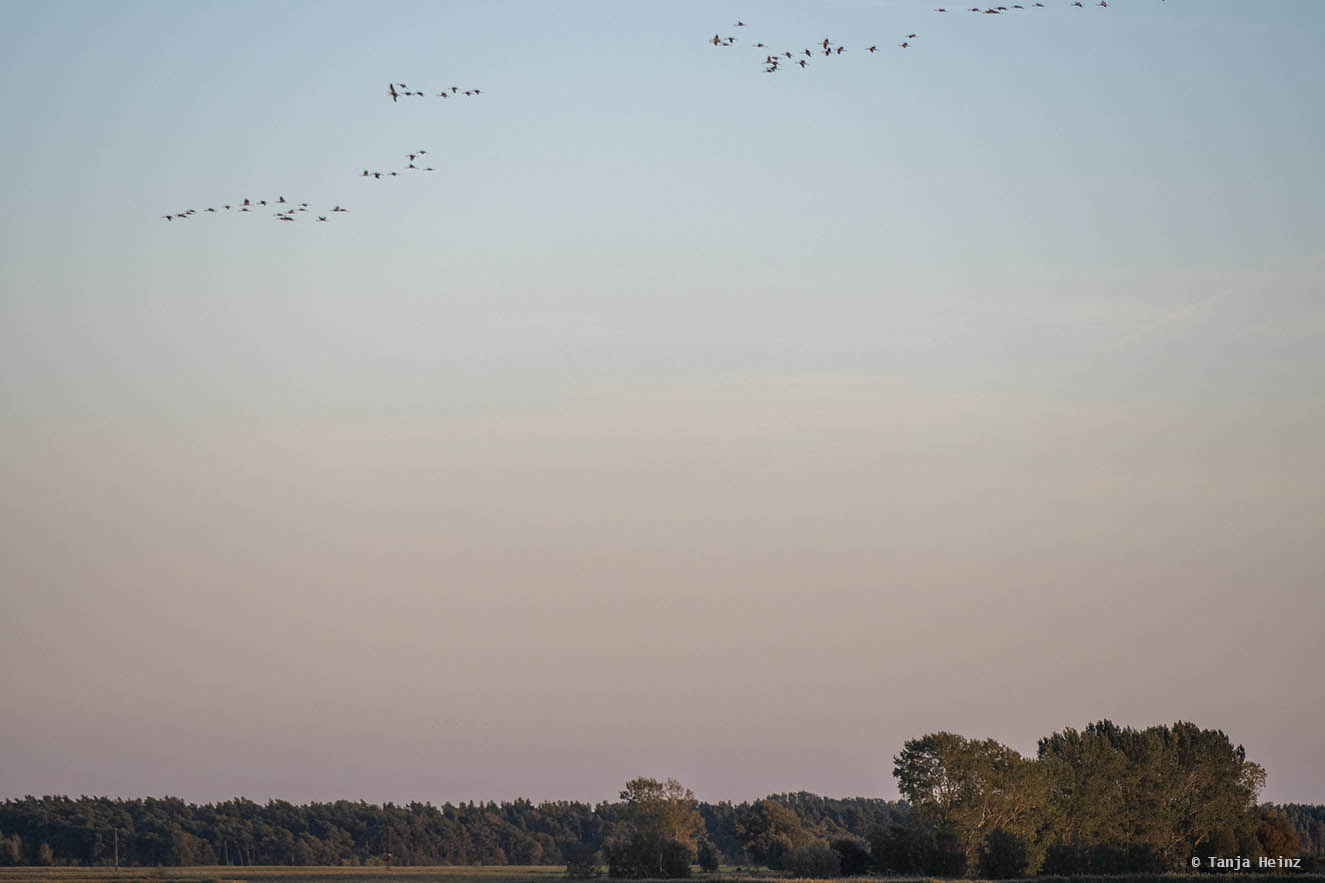
And the sun was slowly disappearing.
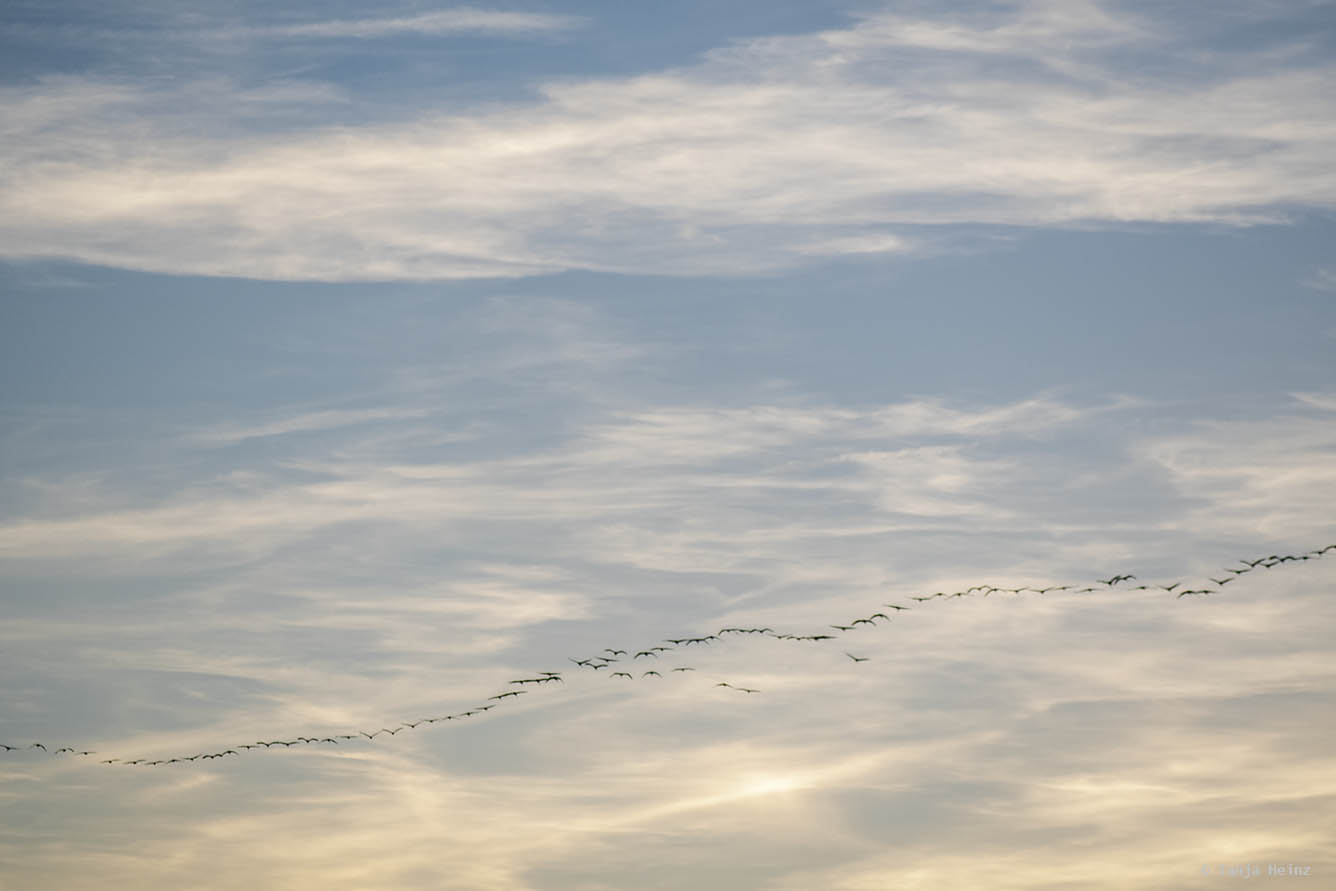
By the way, close to Zingst on Fischland-Darß-Zingst you have good observation possibilities both in the morning and in the evening.
In the morning you can observe common cranes flying out and leaving the island Große Kirr as they spend their day on the fields of Mecklenburg-Western Pomerania searching for food. And in the evening they fly in to their roosting sites.
This way common cranes evade their common predators in the night like, for example, foxes.
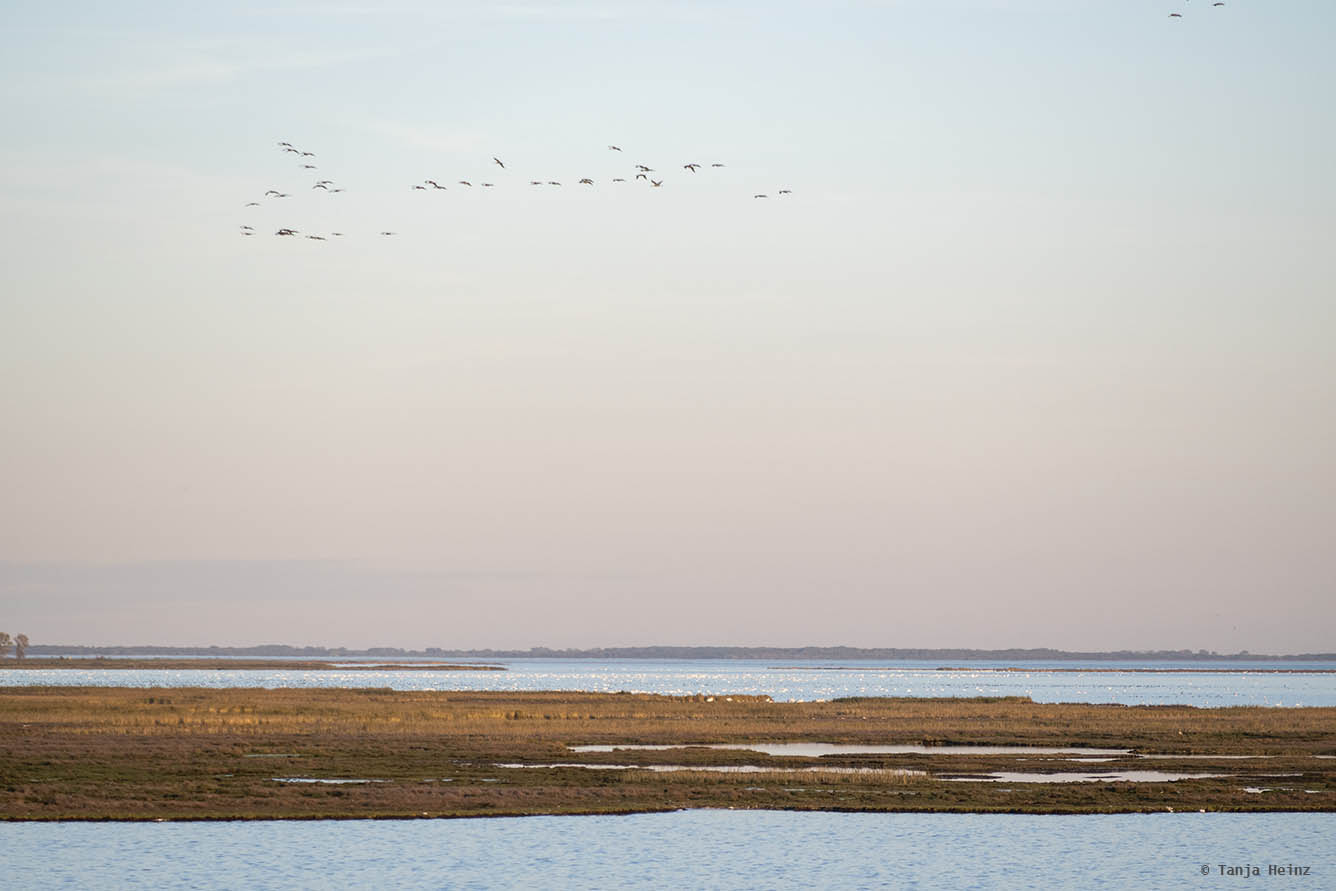
But why do common cranes pass Fischland-Darß-Zingst?
Well, in the fields of Mecklenburg-Western Pomerania common cranes find much food on their migration. On the cornfields around Fischland-Darß-Zingst they find enough food. And thus, the peninsula is a perfect place for them to recharge their batteries.
Common cranes migrate every year twice. In spring and in autumn. However, autumn migration is longer than spring migration.
These cranes breed in northern Europe like Sweden or Finland. Every year in autumn common cranes migrate from their breeding grounds to their wintering grounds, as they spend winters in warmer regions like France, Spain or Africa.
Interesting: Why are cranes known as birds of happiness? The name birds of happiness is originally from Sweden, as the arrival of common cranes indicates the beginning of spring, and thus, warmth, light and food.
This natural spectacle attracts many birders or nature enthusiasts like me.
I cannot put this into words when a flock of common cranes pass just above you.
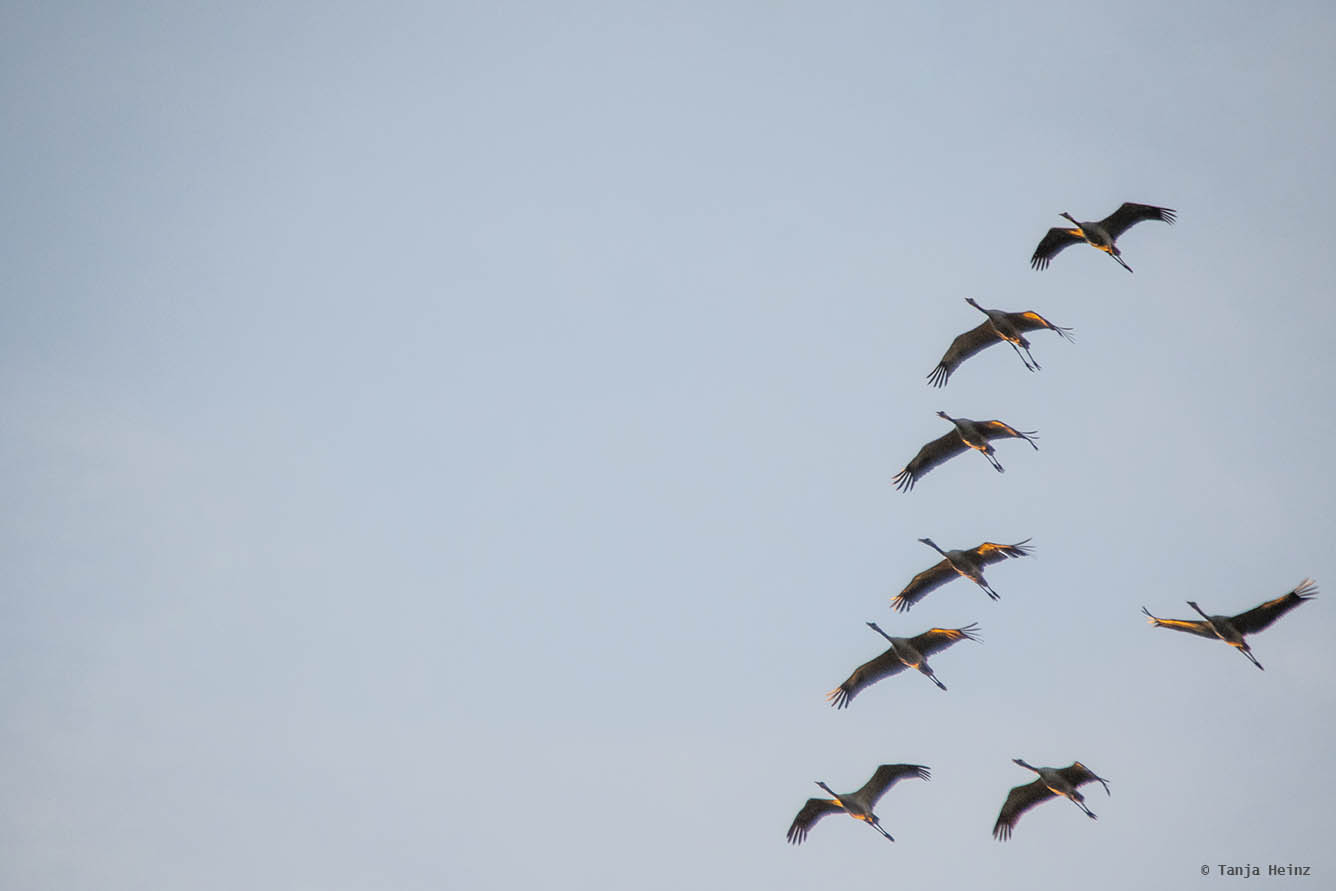
In one moment they were so close.
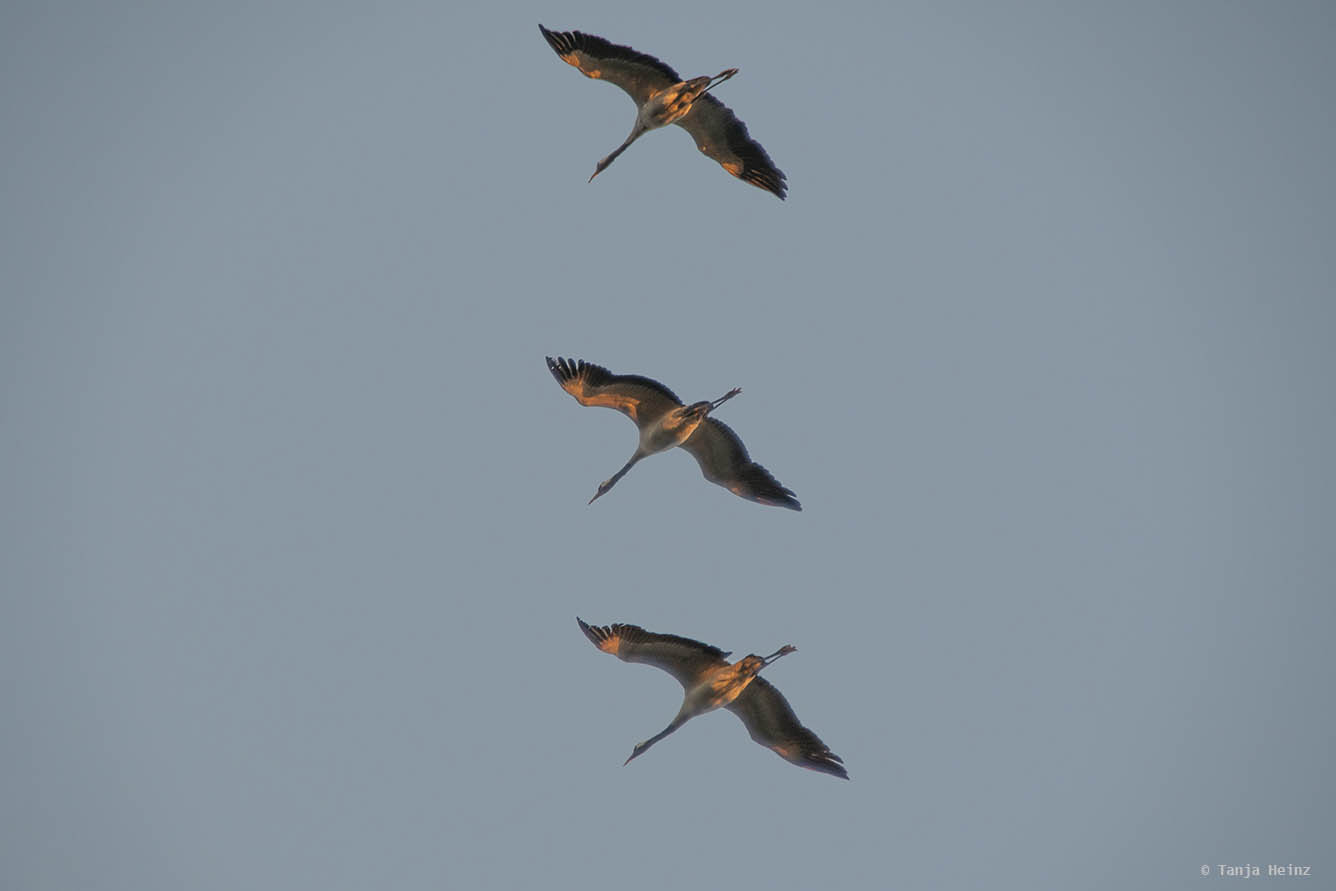
And the sunset on that day was impressive.
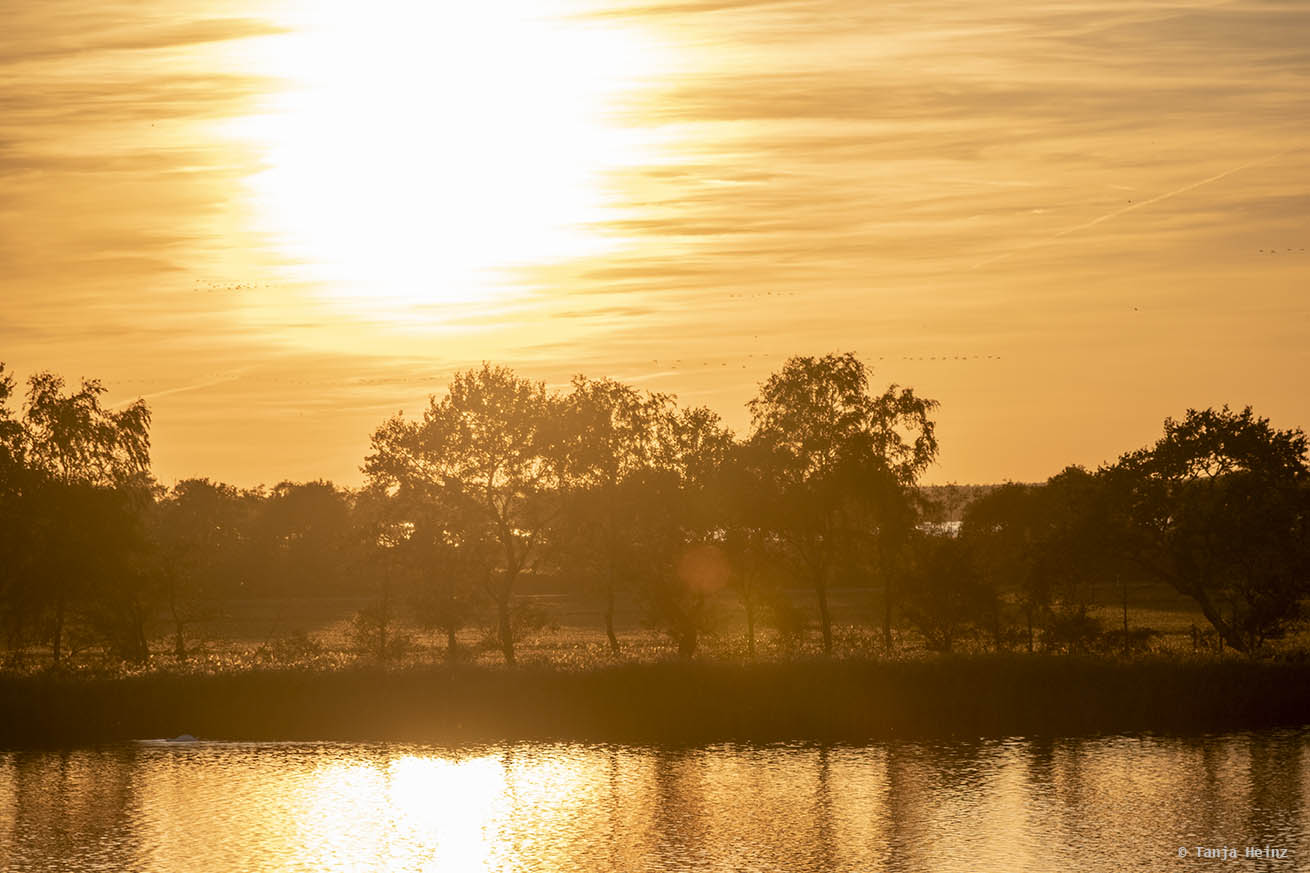
Observing common cranes during sunset is just indescribable.
The warm light of the sun shined on the cranes.
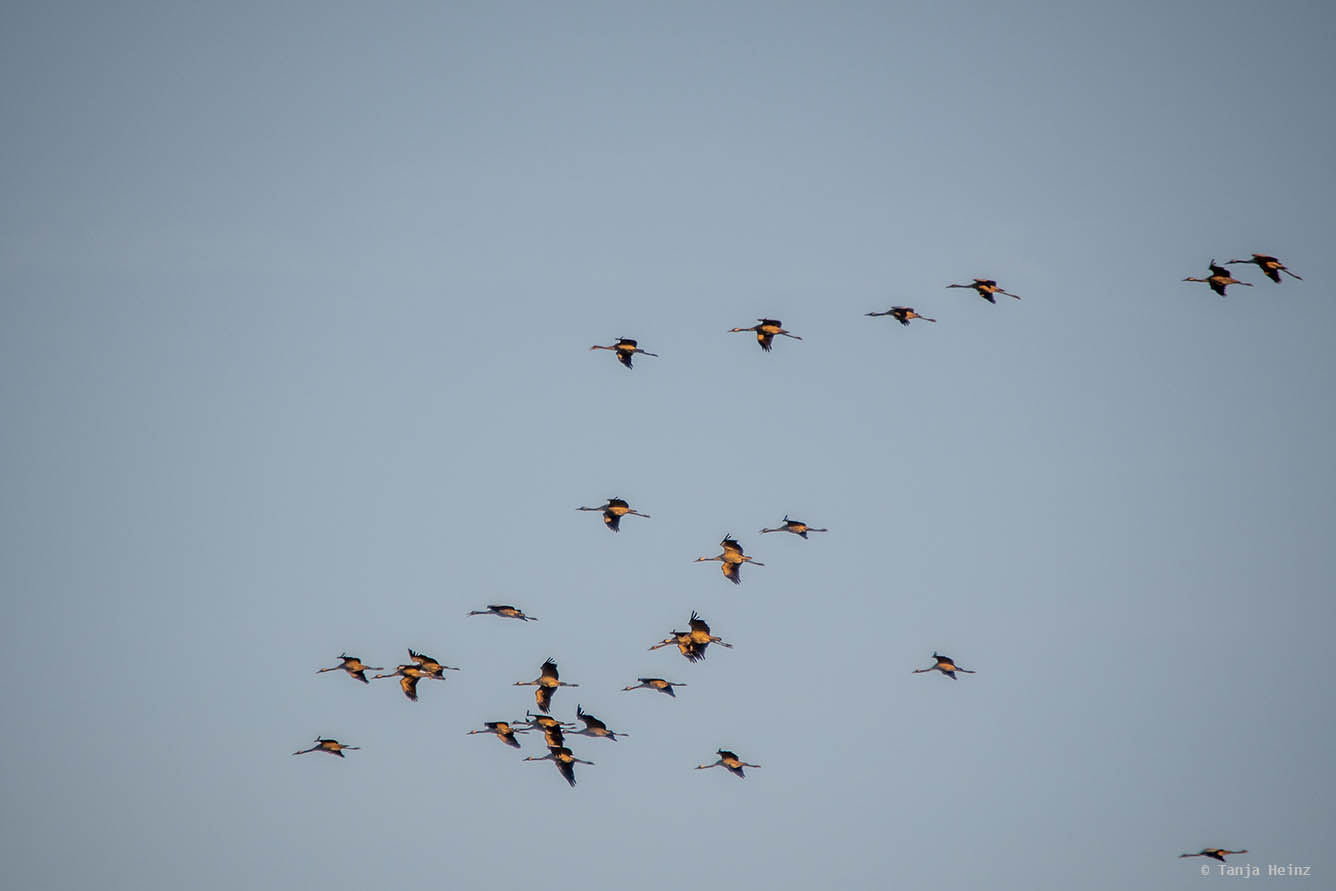
It was even more impressive, as common cranes are such large birds.
With a size of about 1.30 m and a wing span of about 2.20 m, they are larger than white storks or herons.

In my opinion common cranes are with good reason a symbol of happiness.
At least they left me and several other nature enthusiasts with a feeling of happiness.
At the end of the crane watching tour it was getting colder and colder and the sun was more and more disappearing.
For me and the others it was time to say good bye to the common cranes.
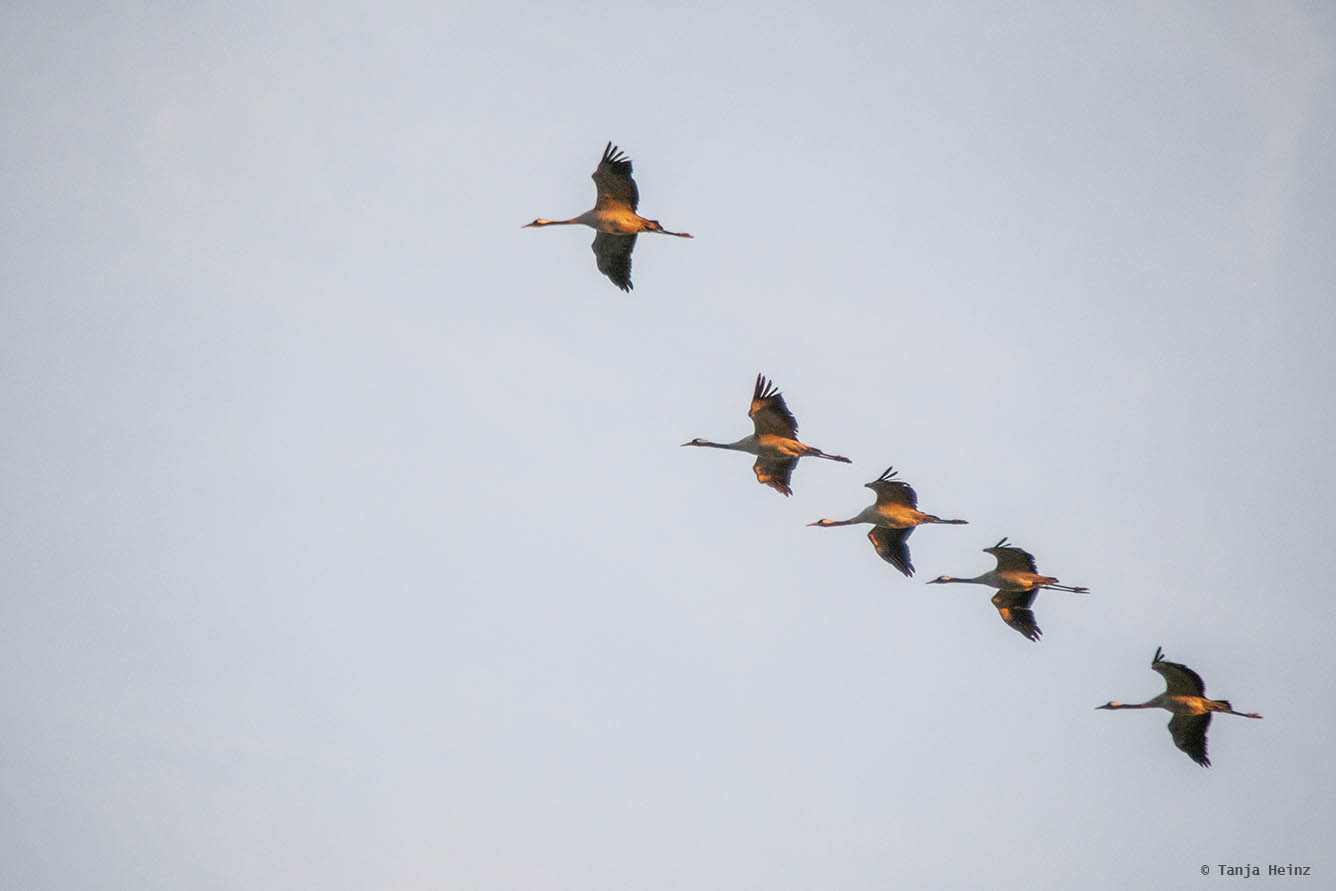
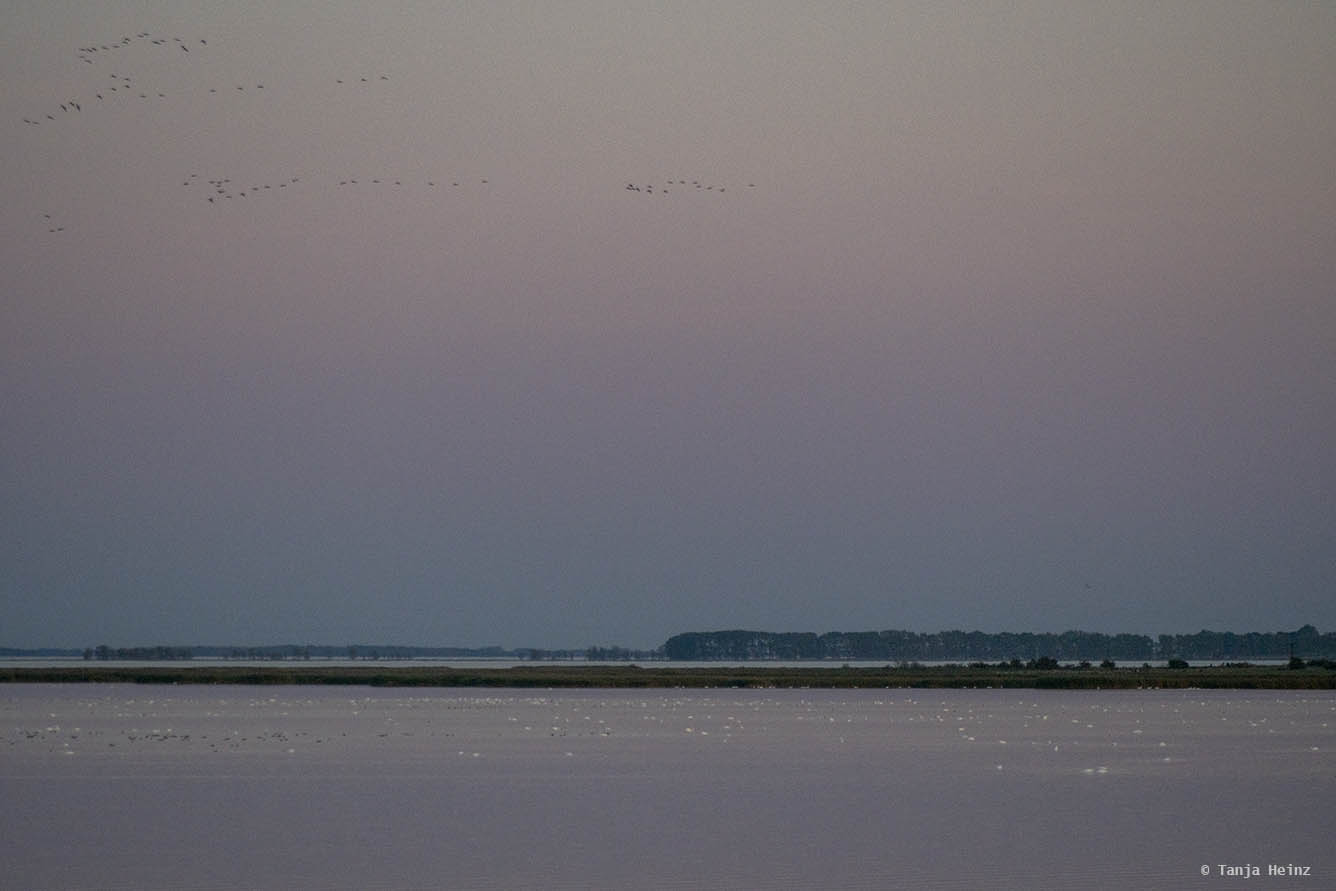
Although there were still cranes flying in, the boat finally had to leave.
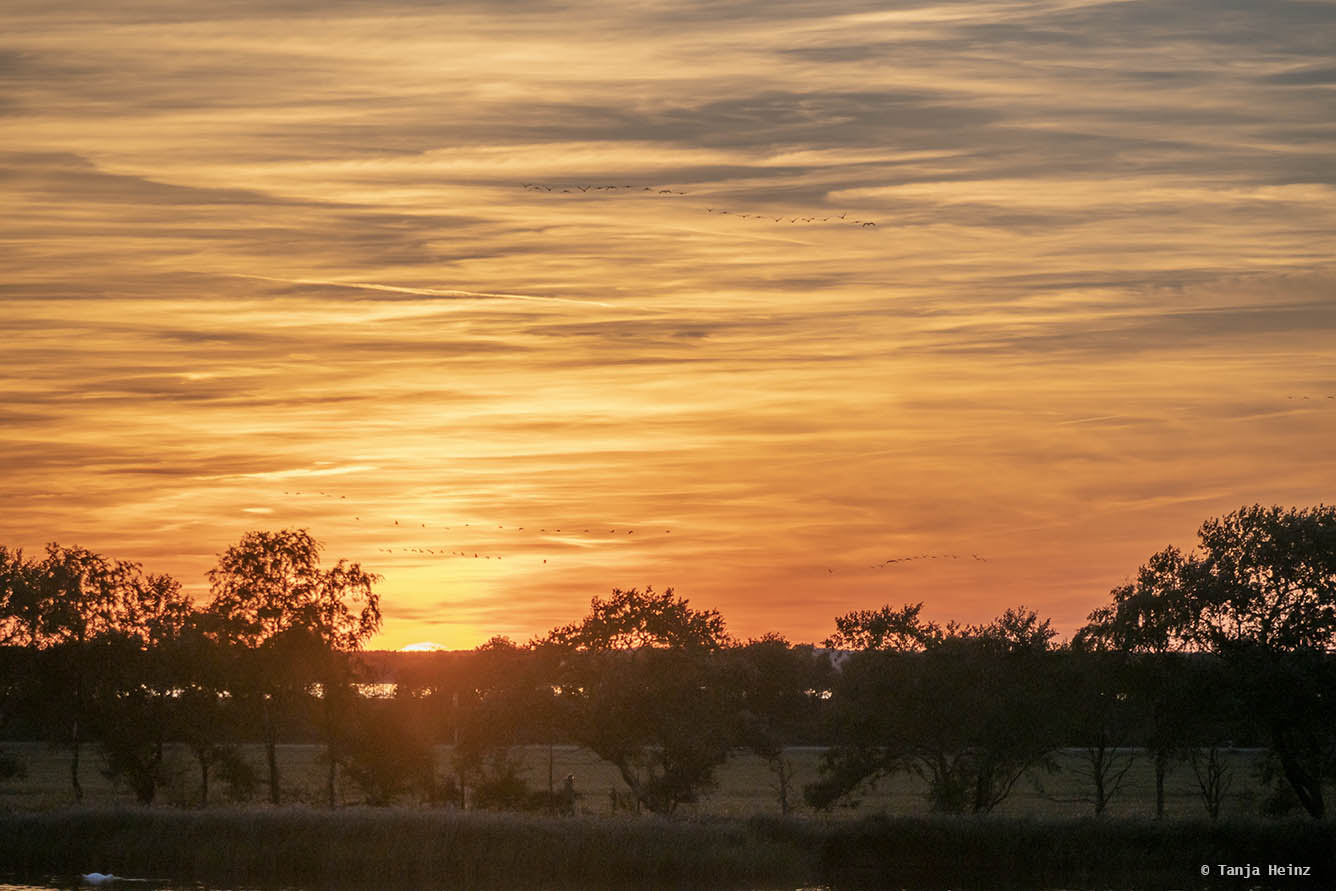
Crane observations on land
There are many more spots on Fischland-Darß-Zingst where you can observe common cranes. As common cranes spend their day on harvested corn fields, you can just watch out for common cranes on fields during the day.
Important: Please do not disturb common cranes. Common cranes are very shy and they have a great flight distance. If you approach common cranes, the birds will leave and they have to search for food in another place. As common cranes roost in Mecklenburg-Western Pomerania to recharge batteries, please do not disturb their feeding habits.
One important spot on Fischland-Darß-Zingst is Pramort in the eastern part of the peninsula. Apparently, it is one of the most important roosting sites for the common crane in Central Europe. As we haven’t been there, I cannot share here my experiences with you. However, if you are interested to go there, please bear in mind that the area is closed every day at 3 p.m. until 8 a.m. from September to November. However, there is a checkpoint in the Sundische Wiese where you can get one of the few entry tickets to observe cranes flying in in Pramort. You will find more information about these tickets in the Zingst Kurhaus or try to check the official website of the national park (see below).
Another great spot to observe cranes on Fischland-Darß-Zingst is close to the entrance to Zingst in the street Barther Straße opposite of the gas station where you can find an observation platform. From there you get great views onto the island Große Kirr.
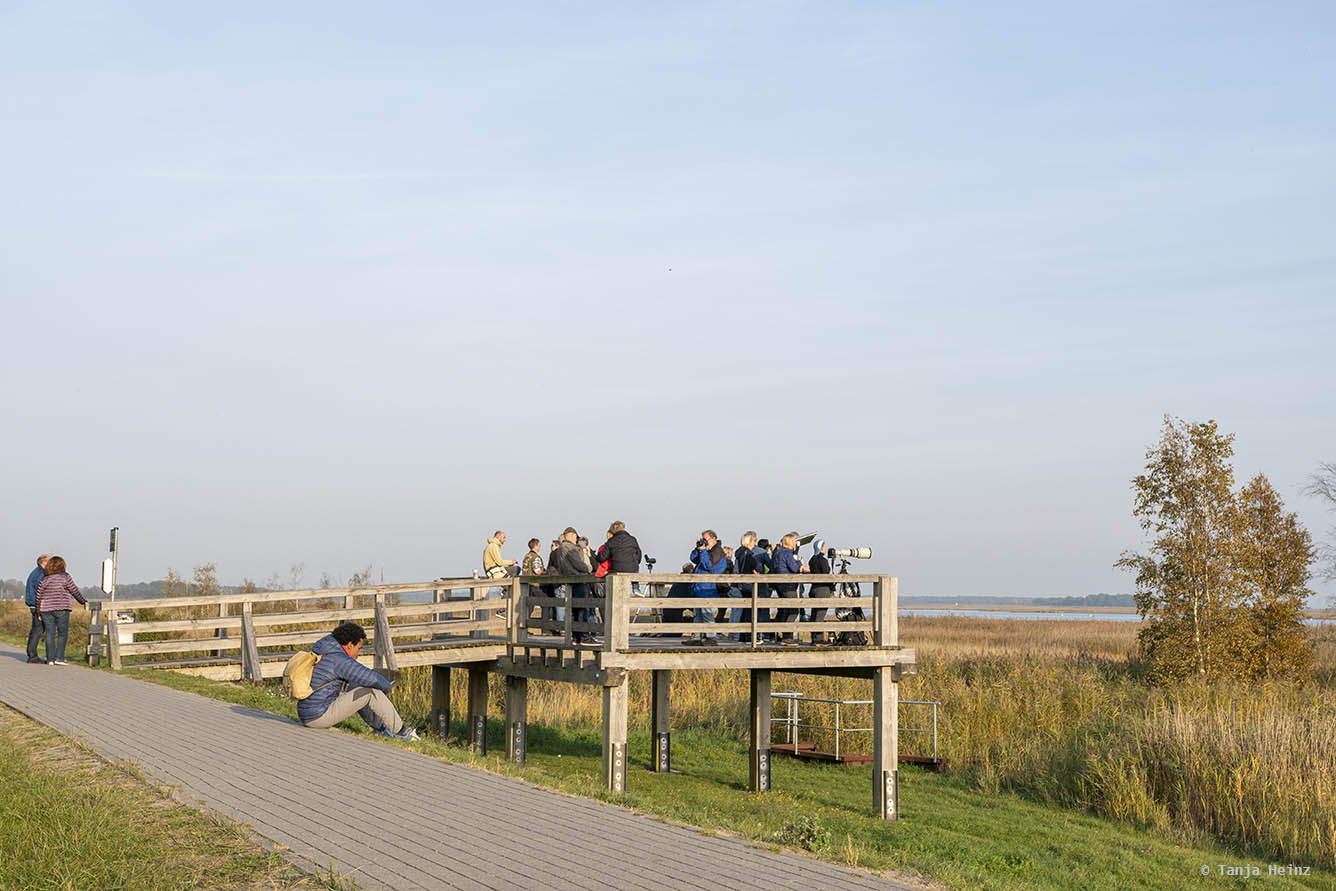
The observation platform was full with many crane enthusiasts, but you can also have wonderful views onto the island Große Kirr and the cranes from the walkway.
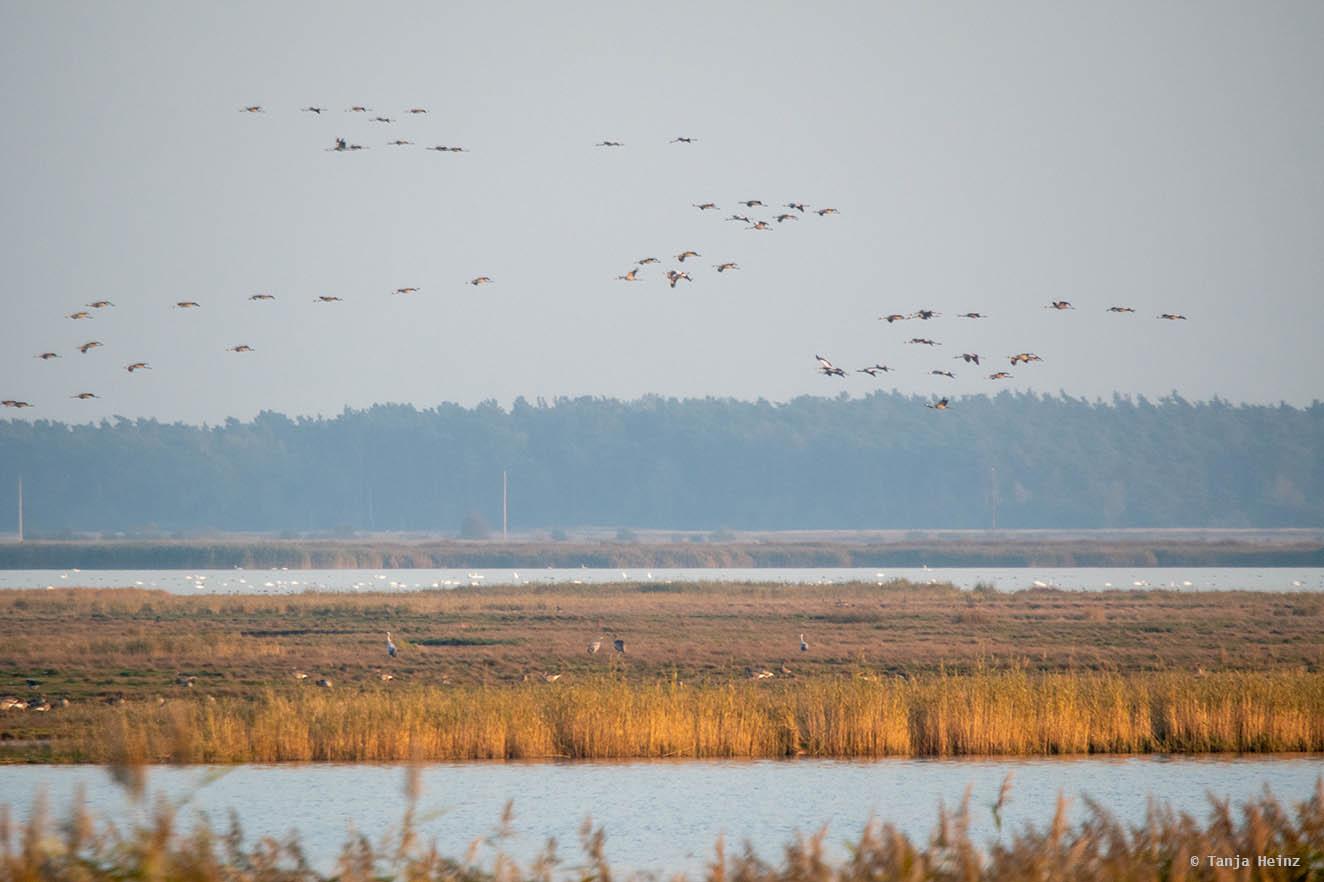
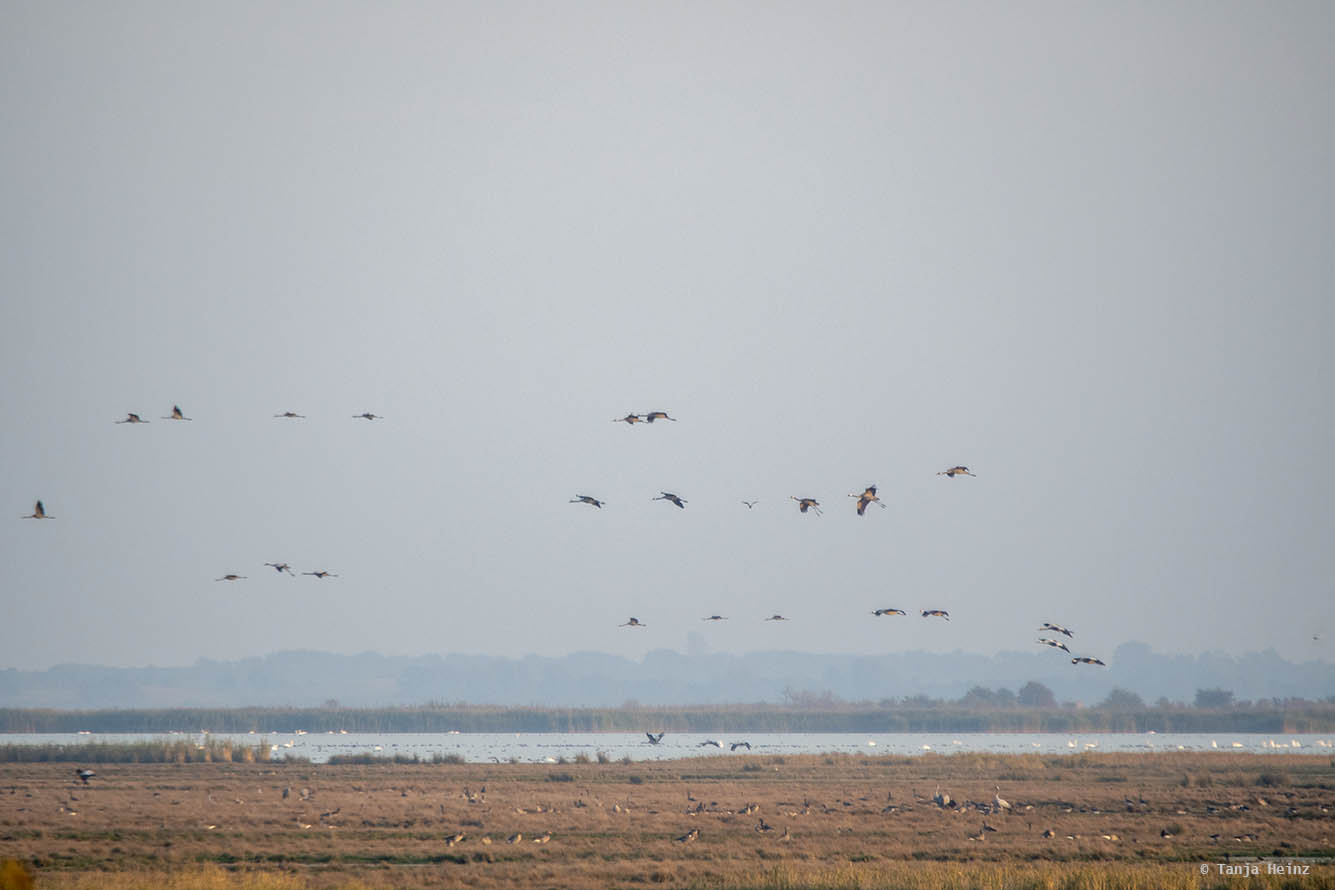
We haven’t been on the Meinigenbrücke (only by boat), but it is apparently also a good place to watch common cranes flying in and out.
Nevertheless, on both days we had best observation conditions with two perfect sunsets.
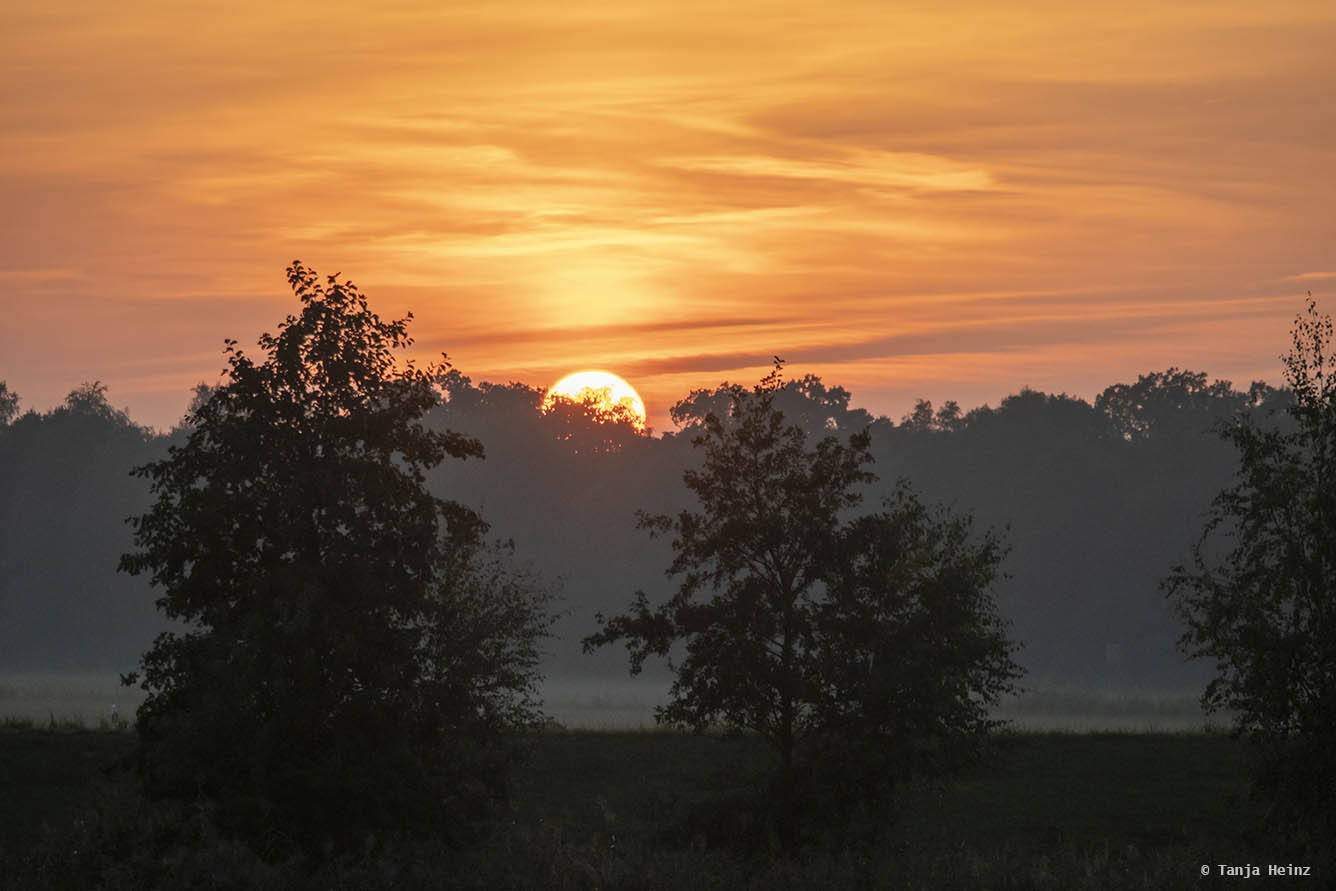
In the following paragraph I tell you more about other wildlife you can expect to see.
Other wildlife on Fischland-Darß-Zingst
We have been on Fischland-Darß-Zingst for three days and two nights. This is definitely too short so see everything the peninsula has to offer.
For example, we missed the yearly rut of deers, that means, the yearly belling of male deers looking for a mate.
We also missed seeing a white-tailed eagle.
Our focus was definitely on the common cranes, thus, we didn’t see so much other wildlife.
However, during our boat trip we saw some other wildlife, especially birds.
As mute swans (Cygnus olor) find perfect conditions in the Bodden, we saw hundreds of them.

We also saw the following birds:
Black-headed gull (Chroicocephalus ridibundus)
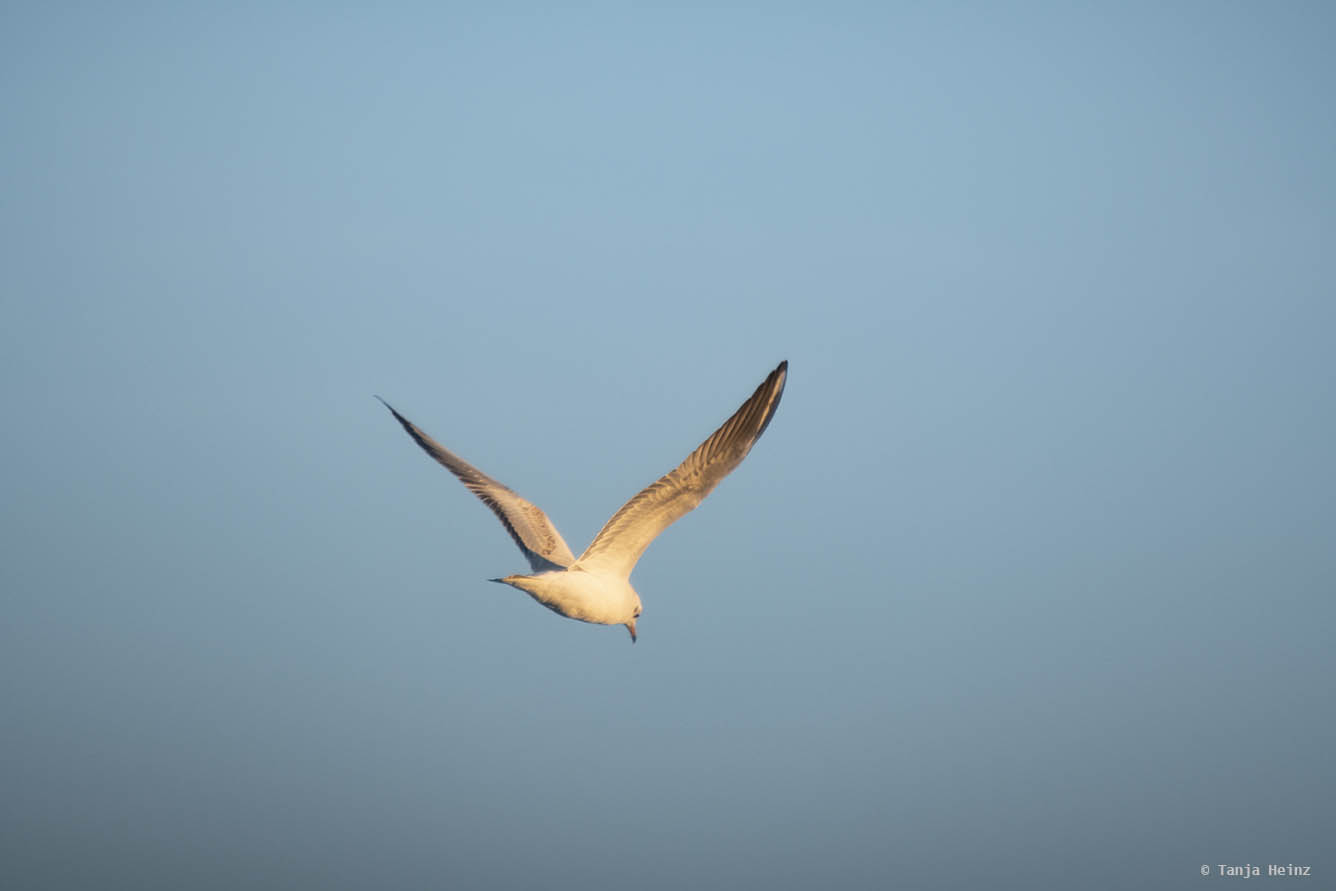
Grey heron (Ardea cinerea)
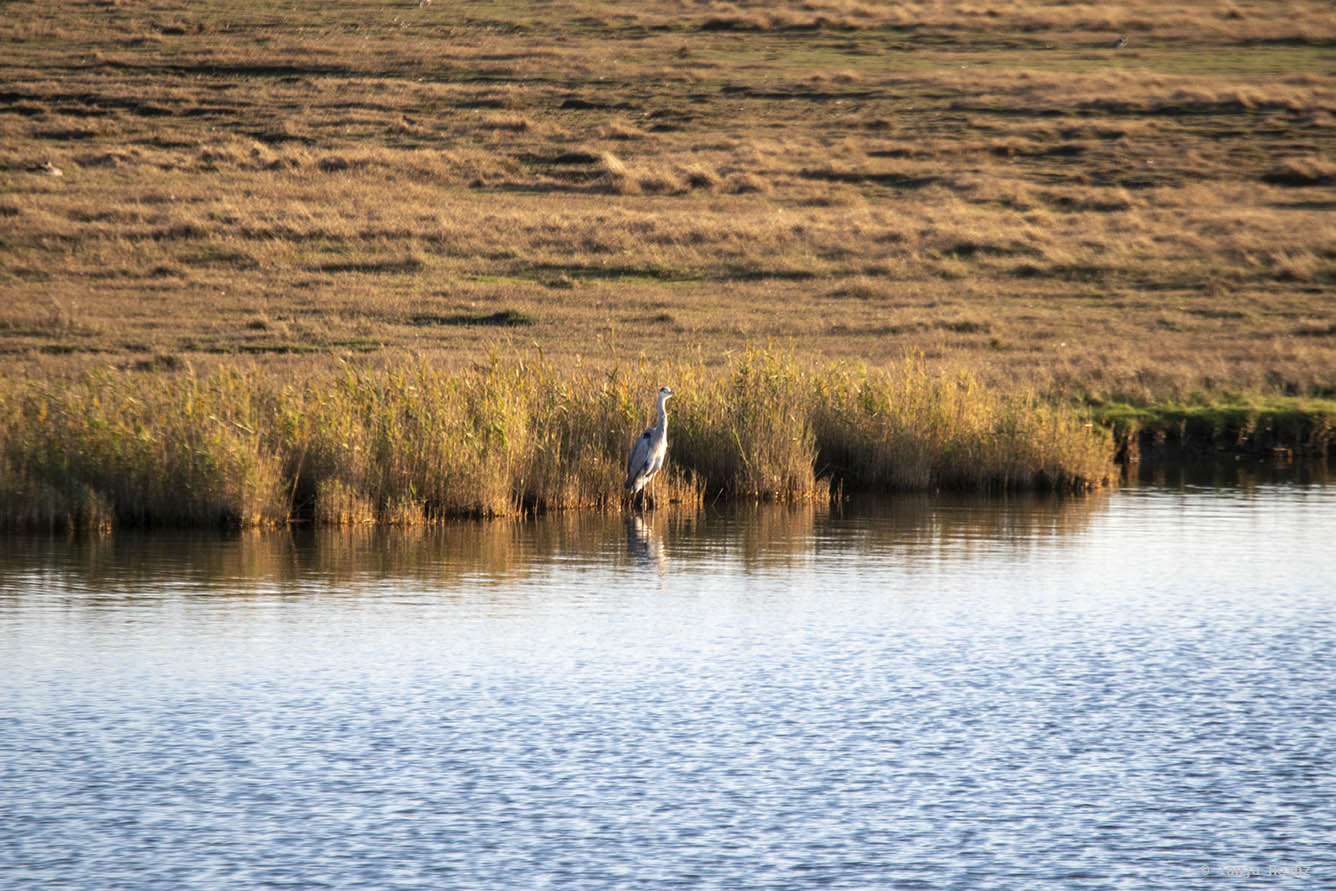
Grey geese (Genus Anser)
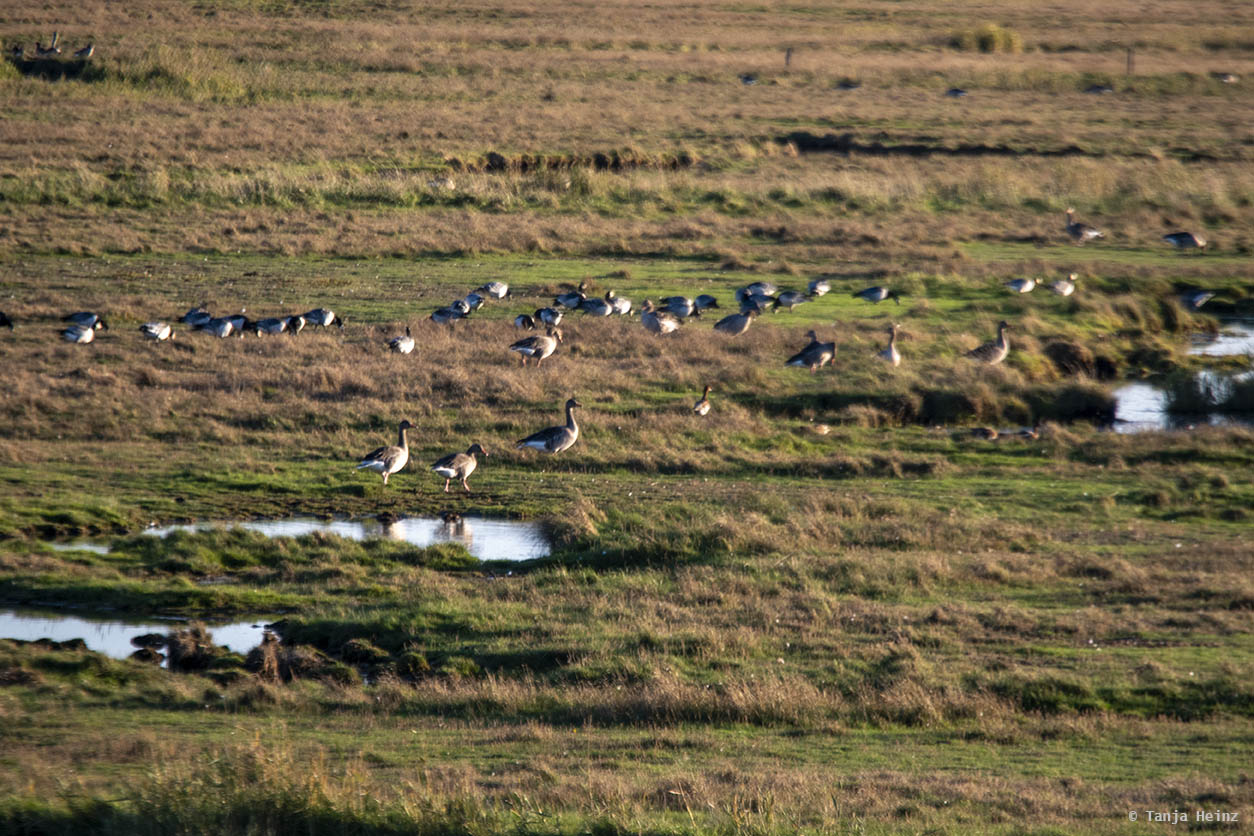
Mallard (Anas platyrhynchos)
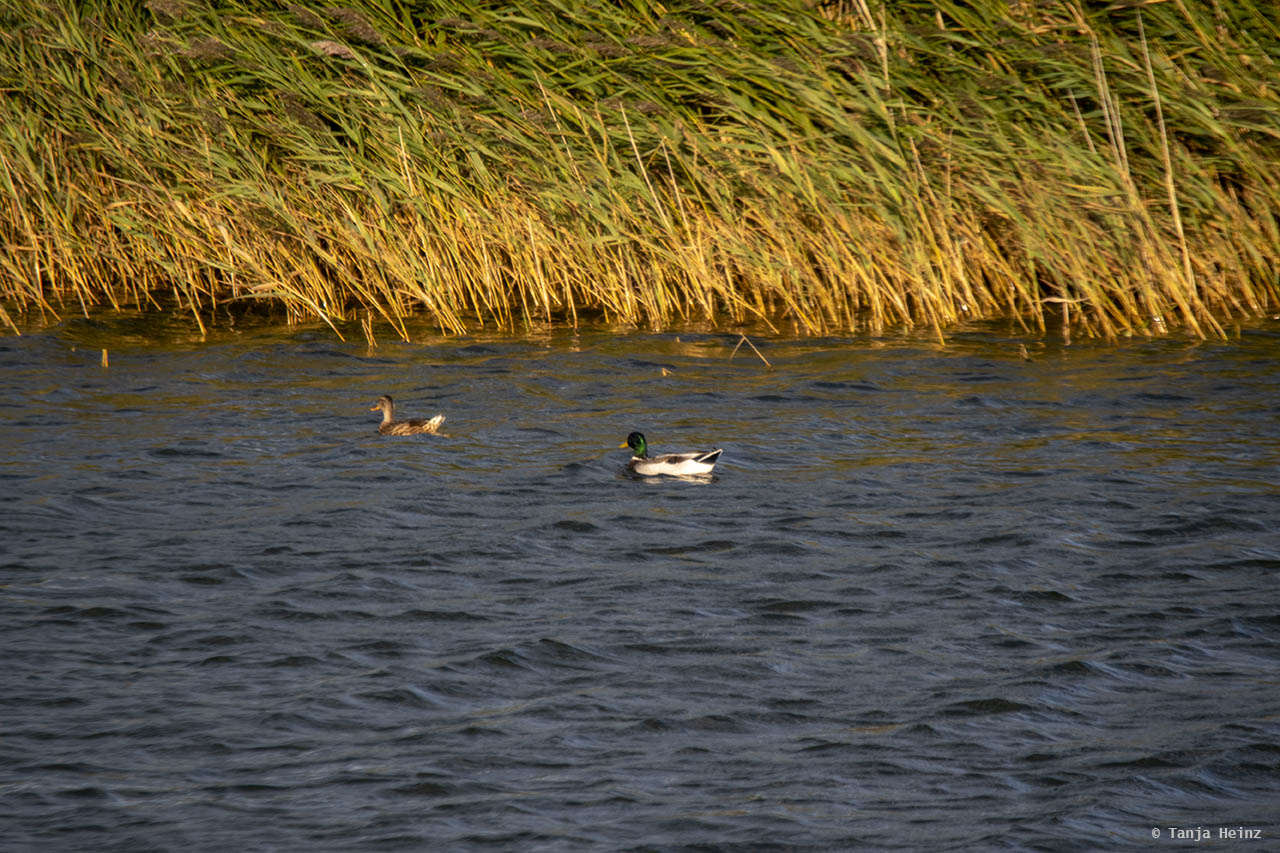
Great Cormorant (Phalacrocorax carbo)
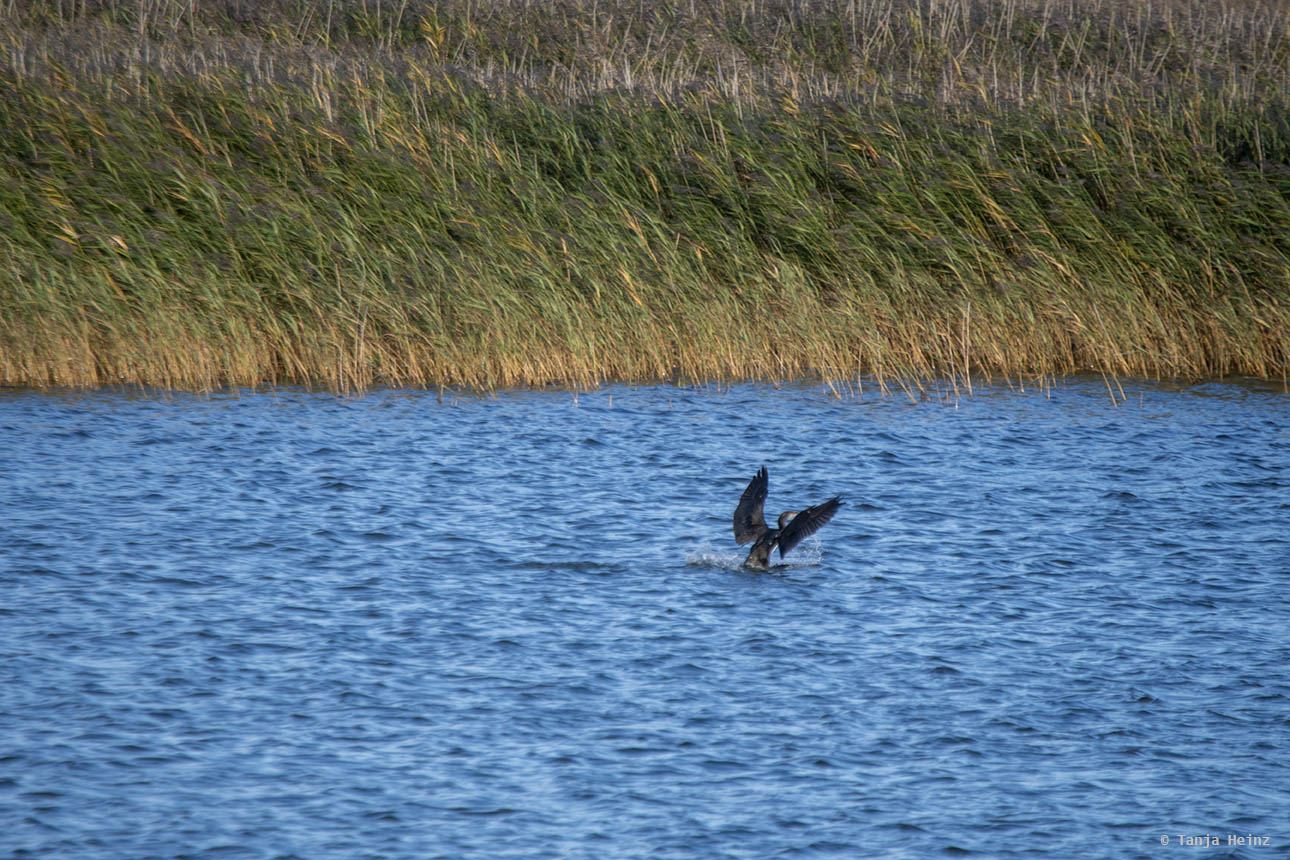
Apart from wildlife you can do many other things on Zingst. In the following paragraph I will give you some ideas what you can do especially during the day.
Places of interest on Fischland-Darß-Zingst
The peninsula Fischland-Darß-Zingst is flat, and thus, perfect for moving around by bicycle as we did. There are several cycle paths connecting Zingst with other parts of the island. On a bicycle tour you can get nice views of the area.
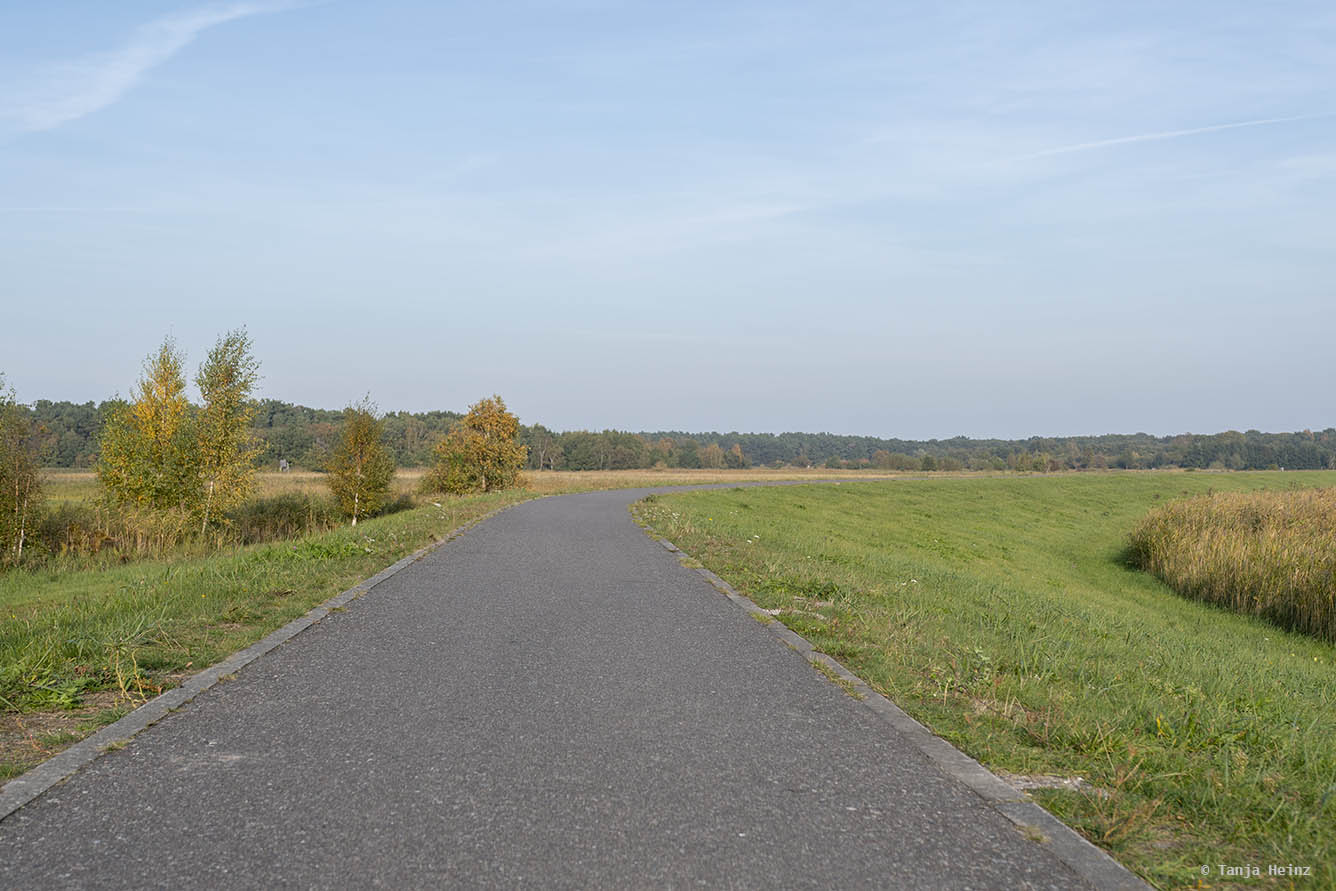
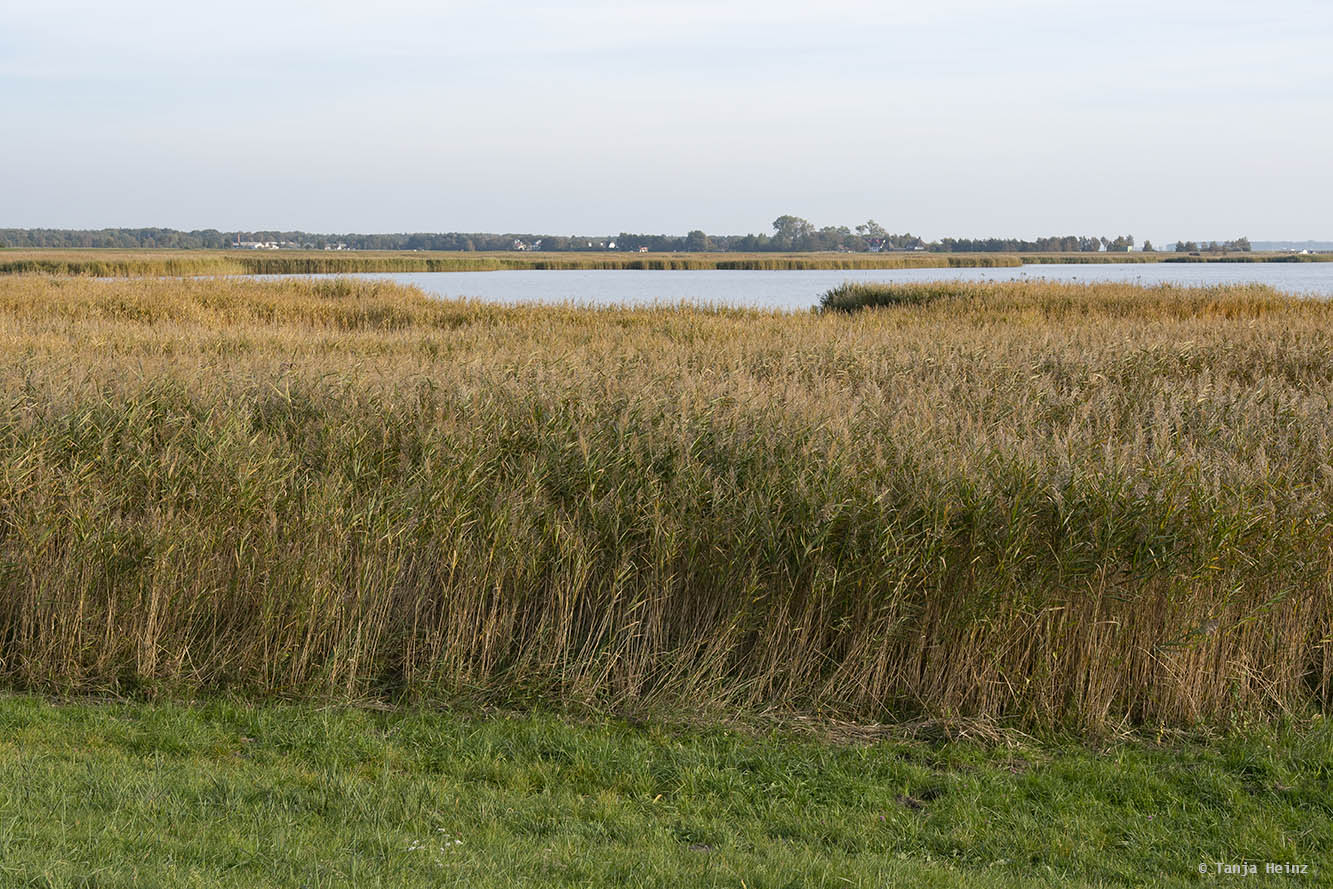
As there are several shops or other places renting out bicycles, it is easy to find the perfect bike to get around on Fischland-Darß-Zingst (see below).
On one day we visited the Darßer Weststrand on the western side of the peninsula. The Darßer Weststrand is located close to the village Ahrenshoop and easy to reach by bike. We cycled from Zingst to Prerow and from there we followed the signs to the Weststrand.
The Darßer Weststrand is a sandy beach with a length of about 14 kilometers.
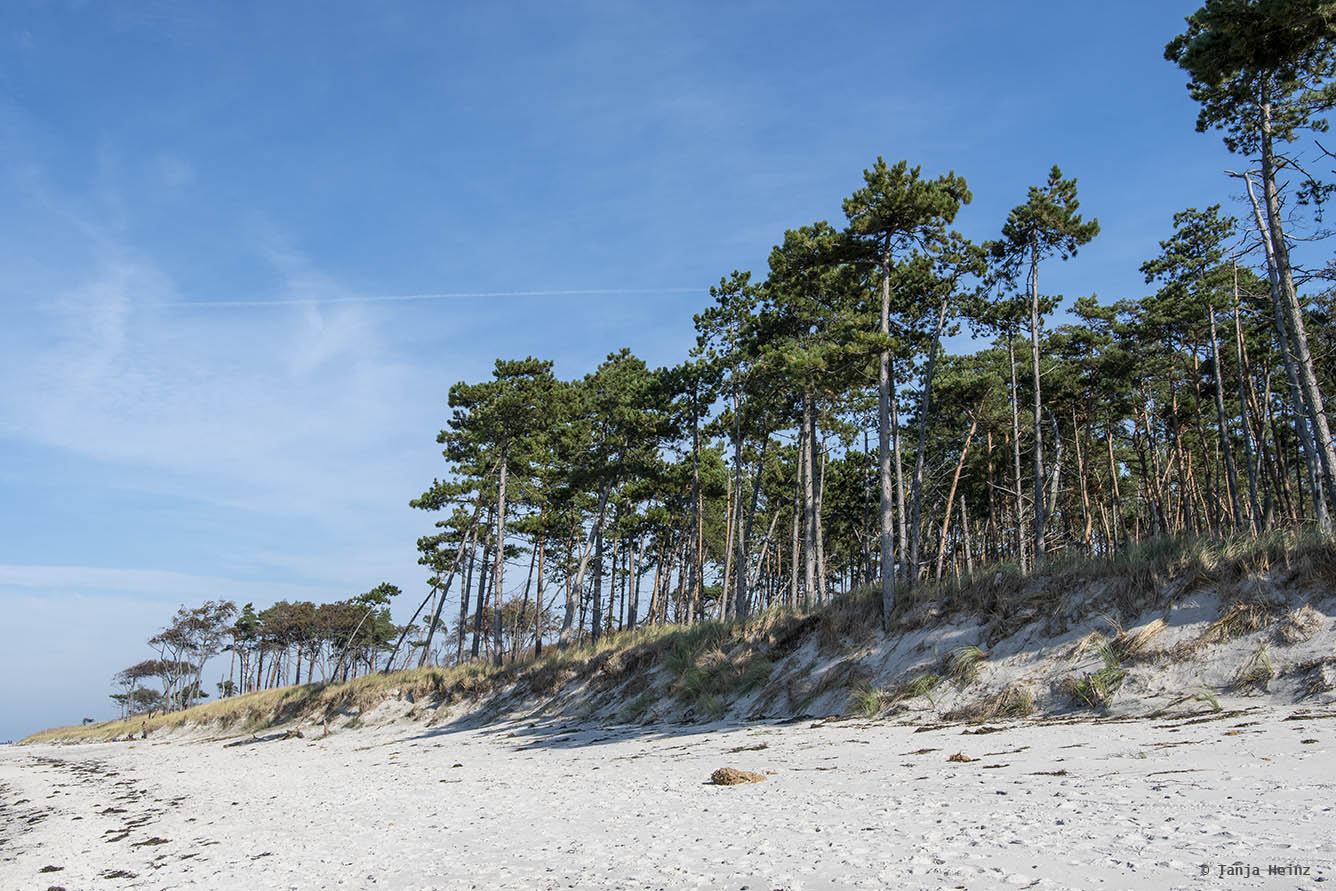
I would describe this coastal landscape as wild and mysterious, being subject to continuous change due to its geographical location.
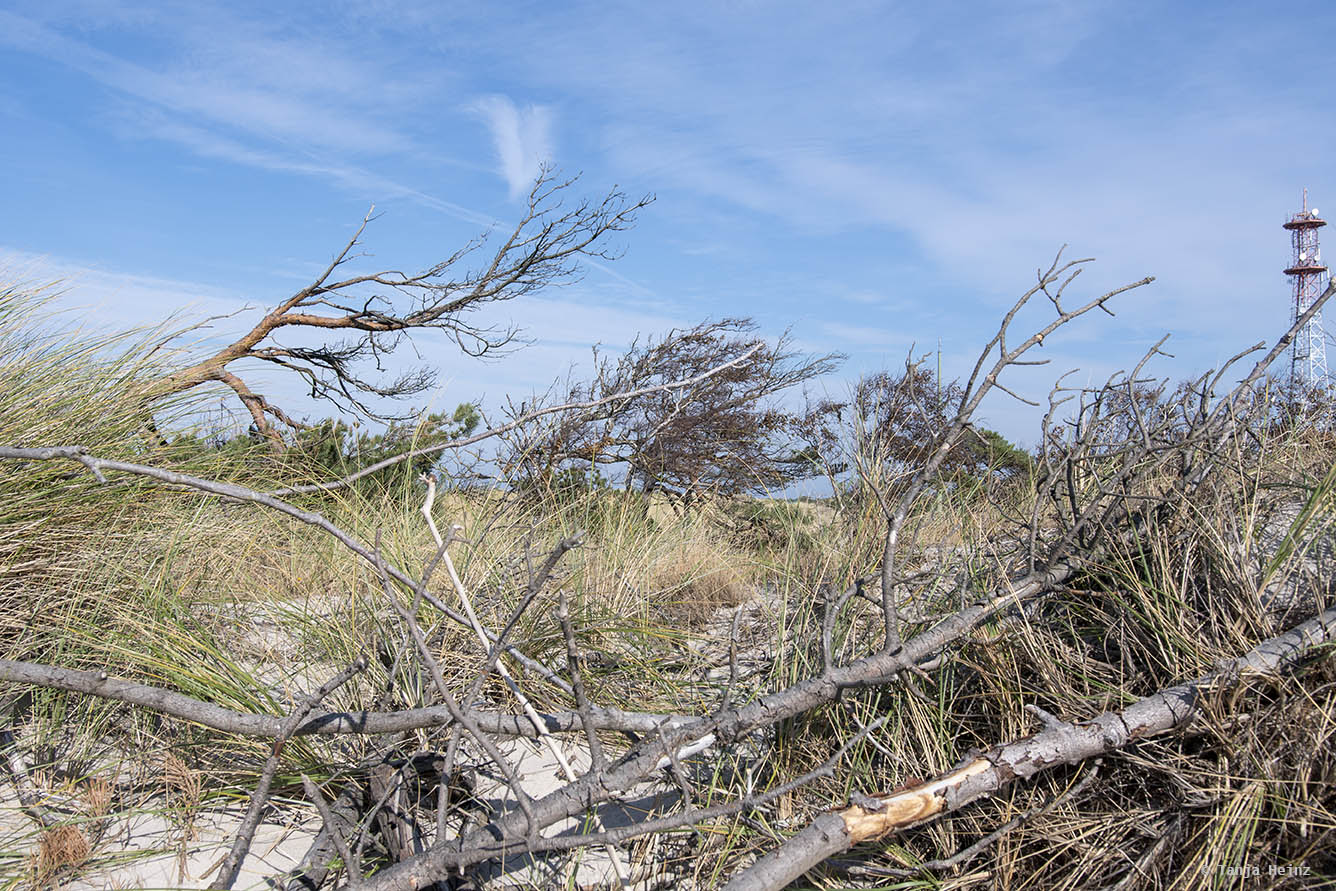
Sometimes you might hear the word "remote" in connection with the Darßer Weststrand.
However, I wouldn’t.
On the day of our visit we met many visitors at the Darßer Weststrand.
It is a place to marvel and dream, but it didn’t feel like a remote place.
At least close to the NATUREUM (a museum at the Darßer Weststrand) and lighthouse in the north west of the peninsula we encountered quite many other visitors (but it might be different if you go farther afield).
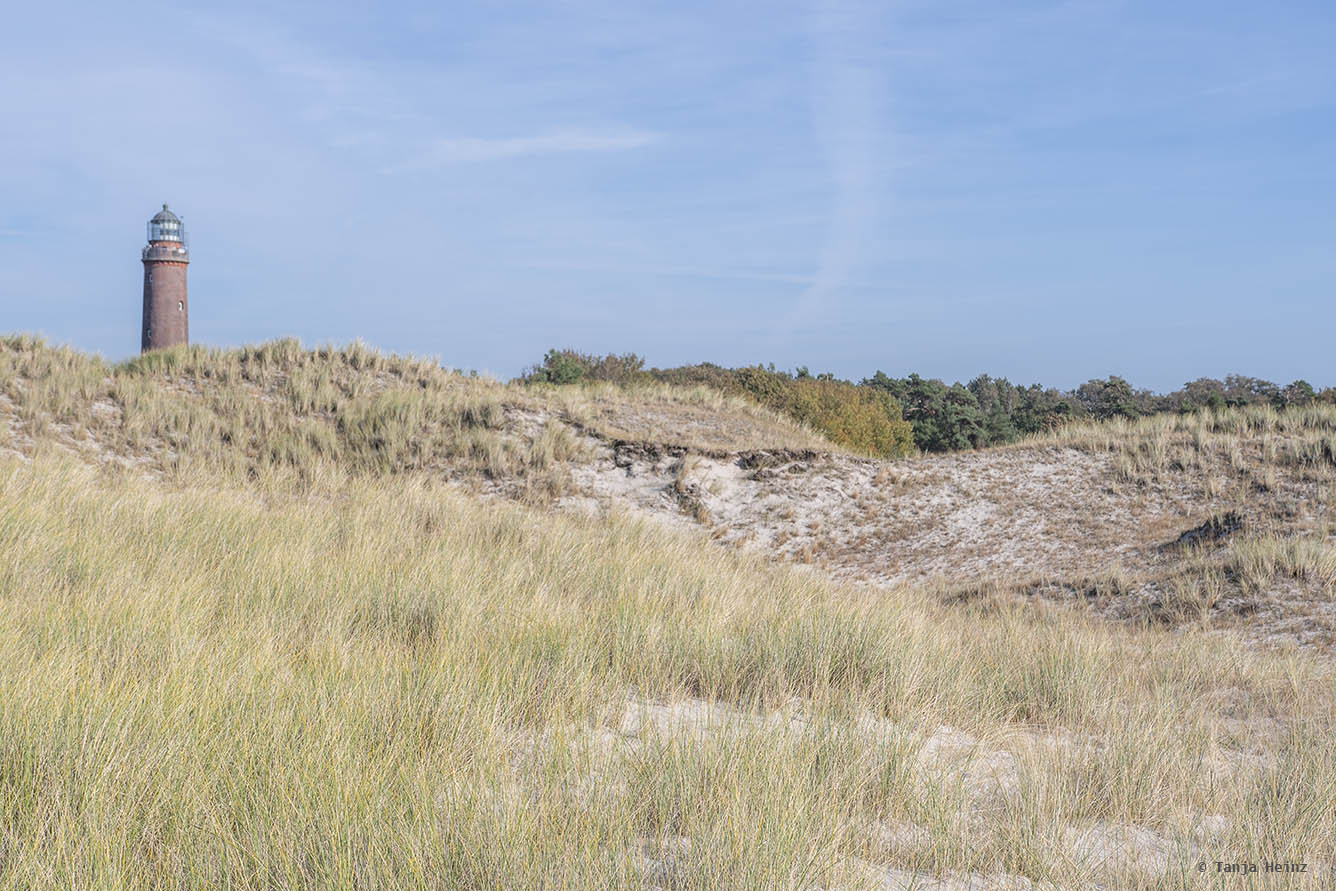
The Darßer Weststrand is located just next to the forest Darßwald, and thus, surrounded not only by untouched dunes, but also by many trees. Some trees even had fallen down after a storm.

Apropos storm.
Have you ever heard of windswept trees?
If no, at the Darßer Weststrand you can see many of them.
Windswept trees are trees which were shaped by strong winds from one direction.

As the winds at the Darßer Weststrand are so strong, you can see many trees in the weirdest forms.
These windswept trees are very typical for the Weststrand and attracts many visitors like me.
Maybe these trees are the reason for so many visitors?
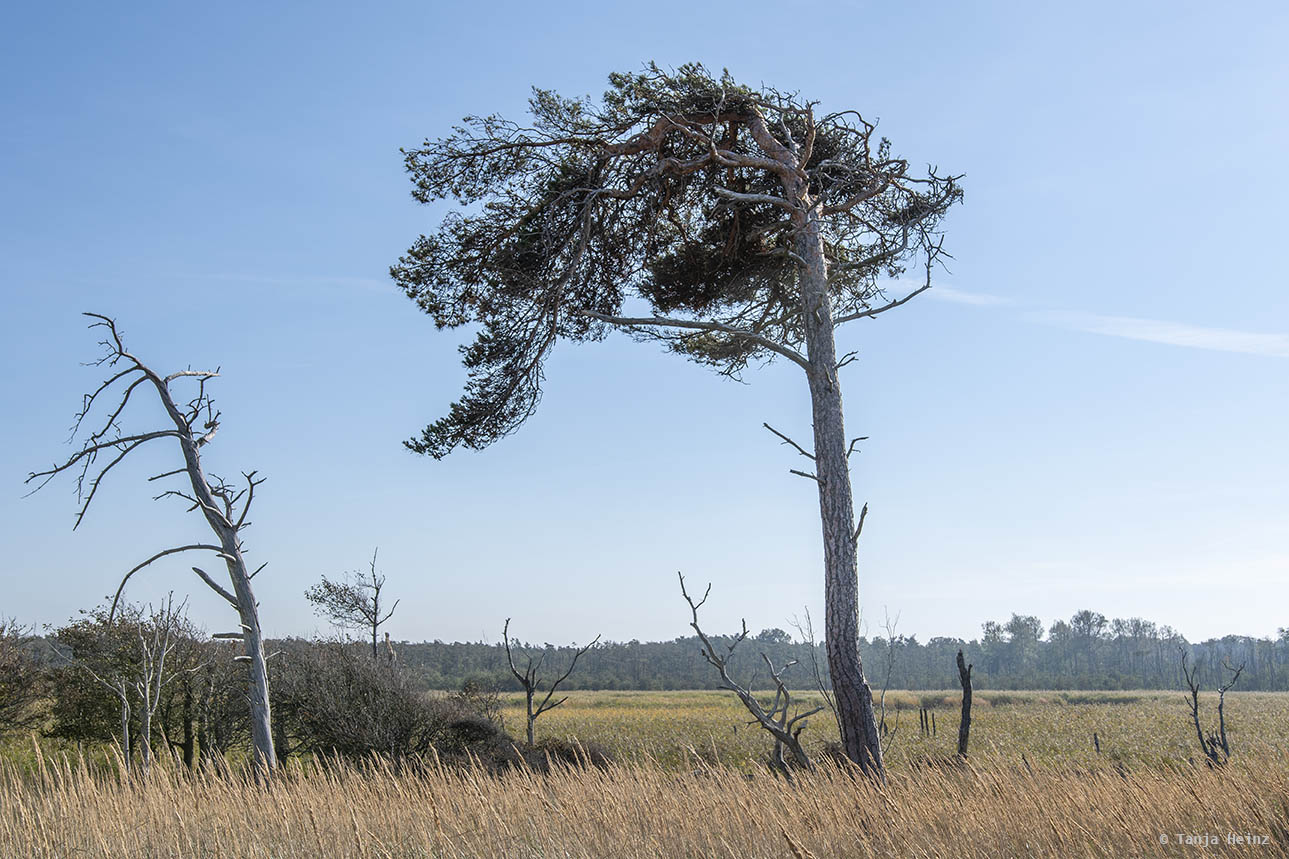
Or is it because the television channel Arte nominated the Darßer Weststrand to one of the 10 most beautiful beaches on earth?
I don’t know.
But I know that it is a really wonderful place to spend time on Fischland-Darß-Zingst.
Another nice point of interest in Zingst itself is the Seebrücke and the beaches close-by.
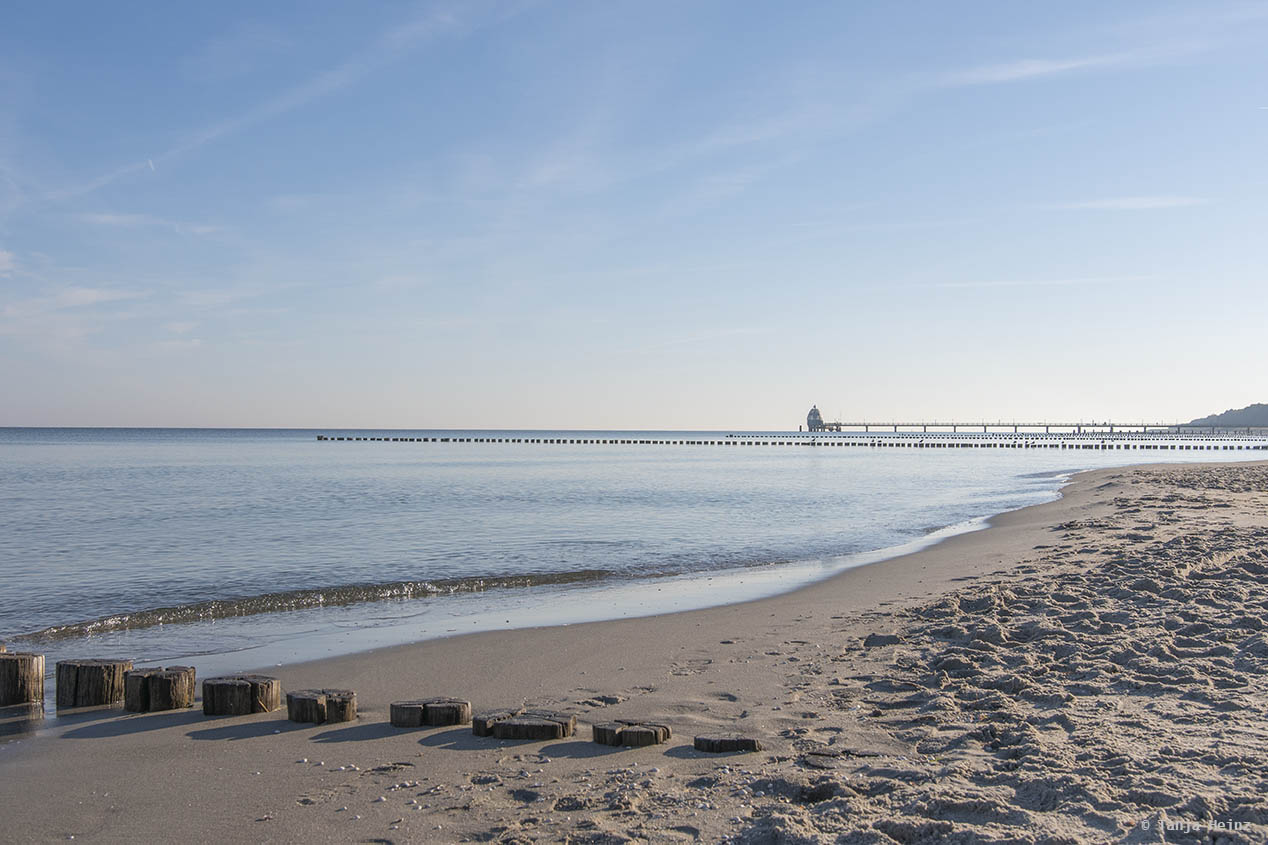
Just next is the Kurhaus Zingst.
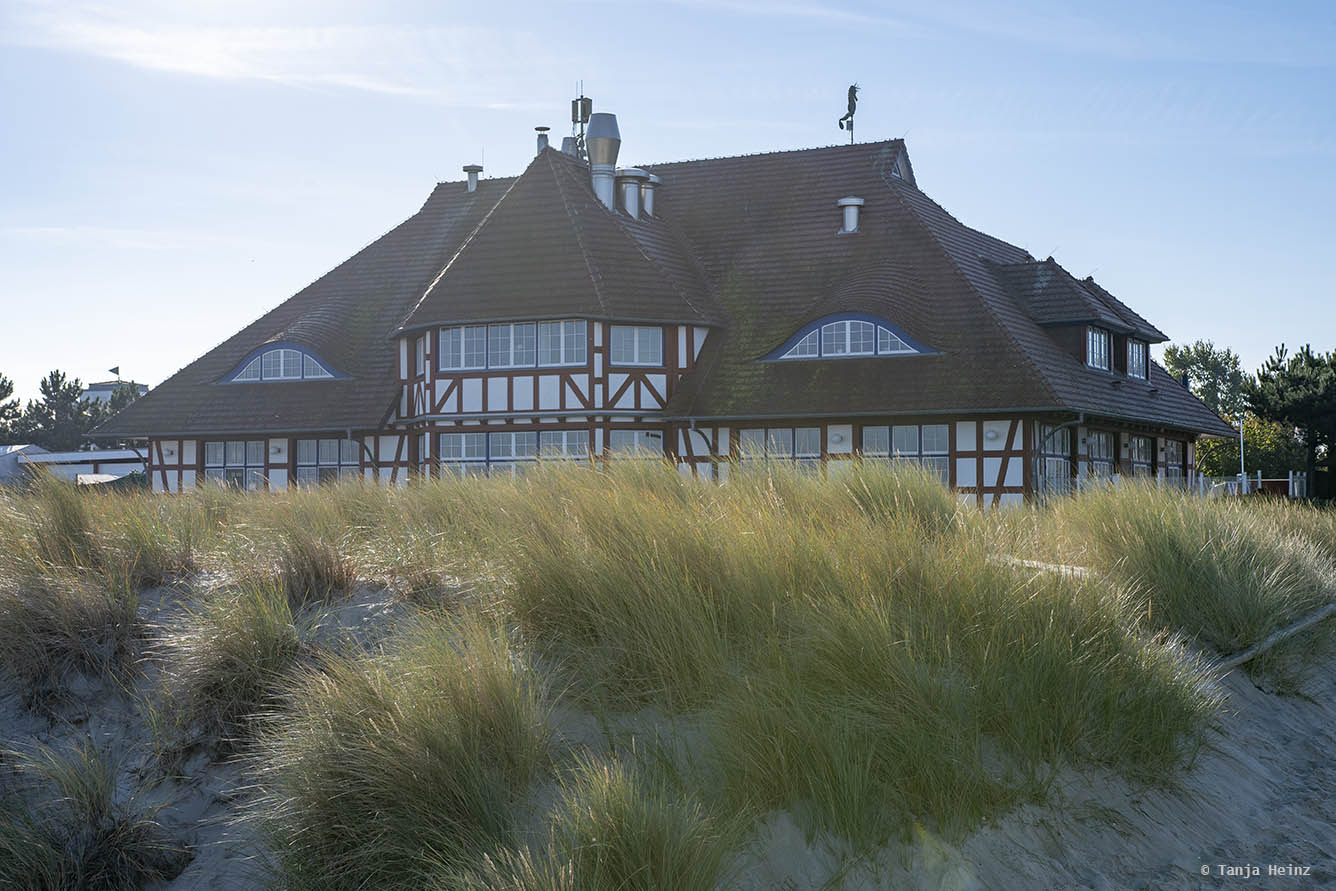
We did not enter the Kurhaus Zingst, but instead explored the surrounding beaches.
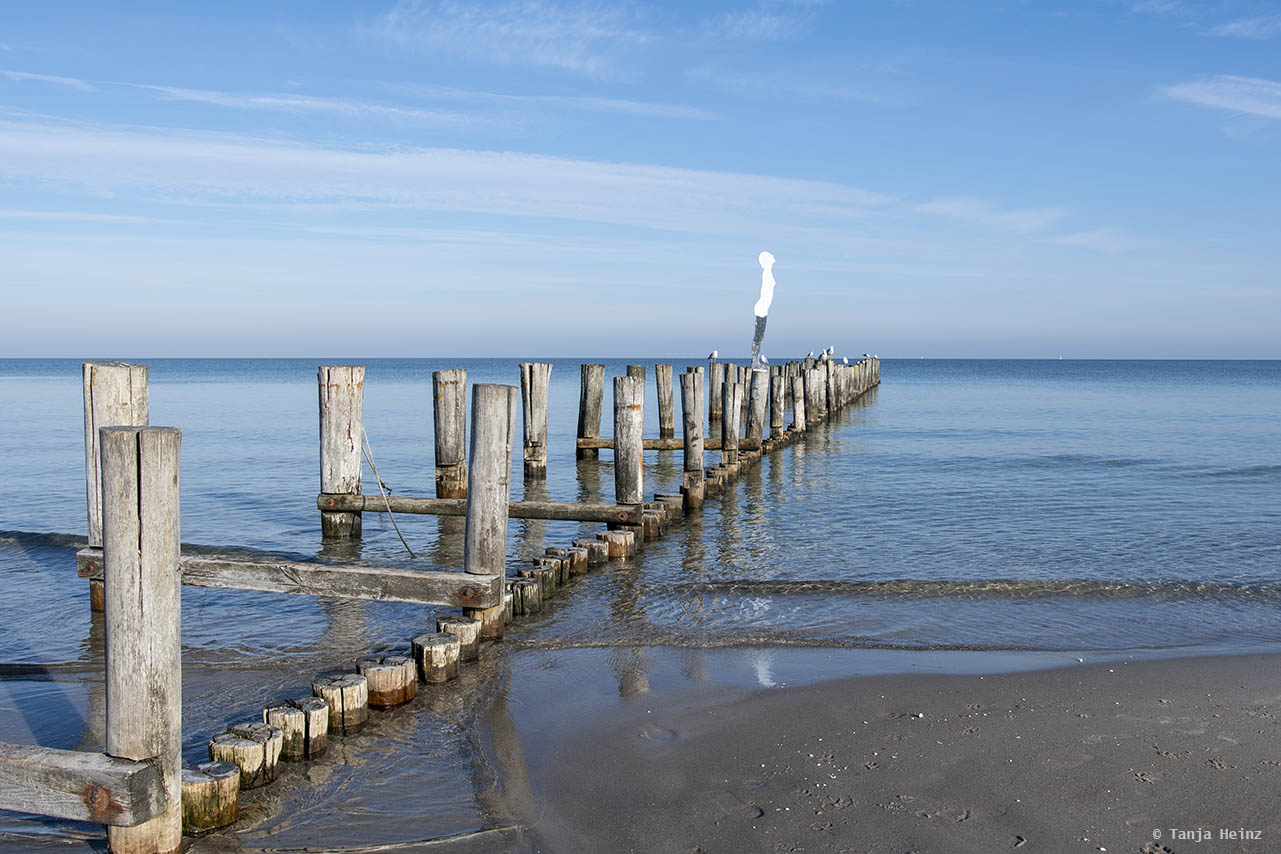
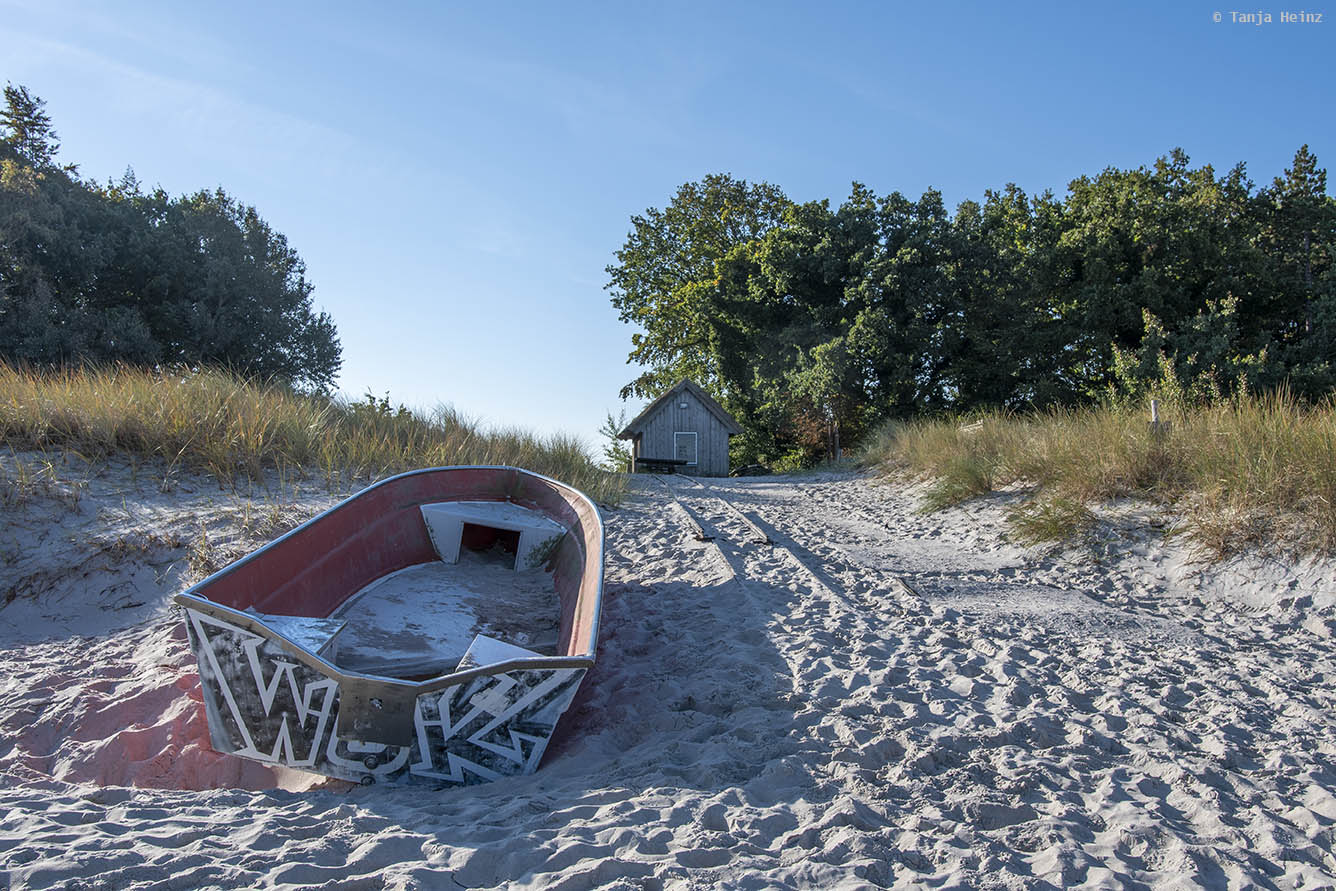
It was a warm and beautiful Sunday in October.
We met some other beach walkers.
As it was such a nice day you could even take a seat in one of the traditional Baltic beach chairs.
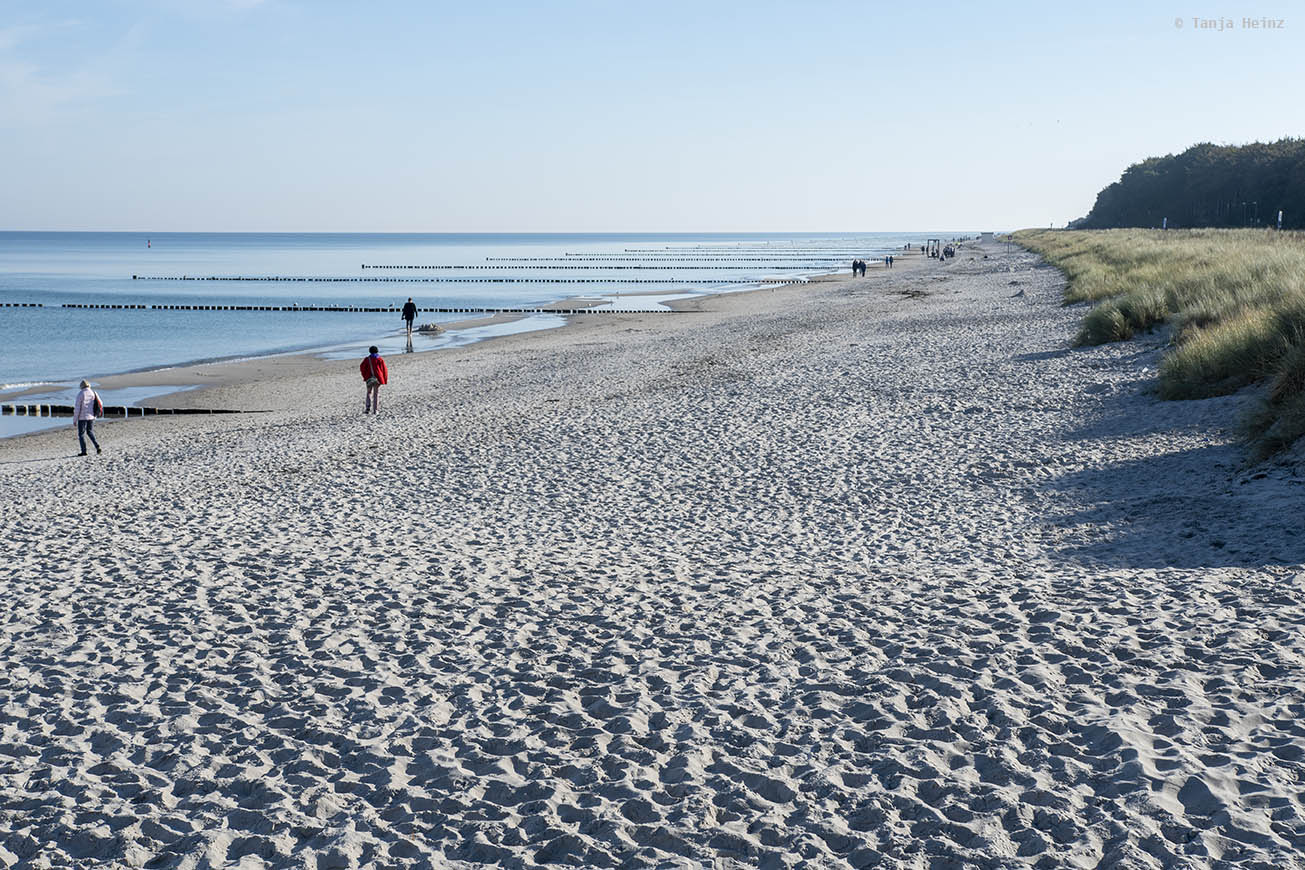
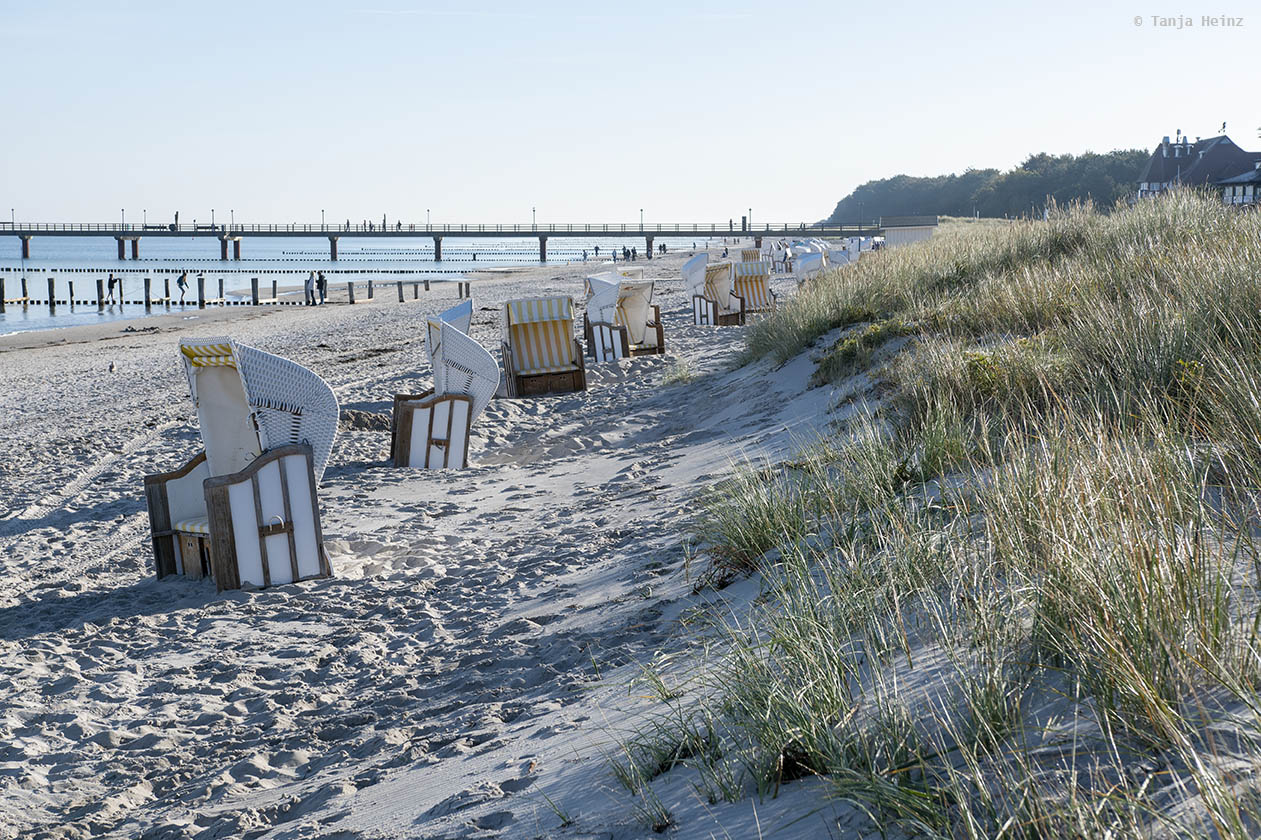
It is also worth to stroll around the center of Zingst close to the Seebrücke. It is a lively place where you can see also some very typical thatched cottages.
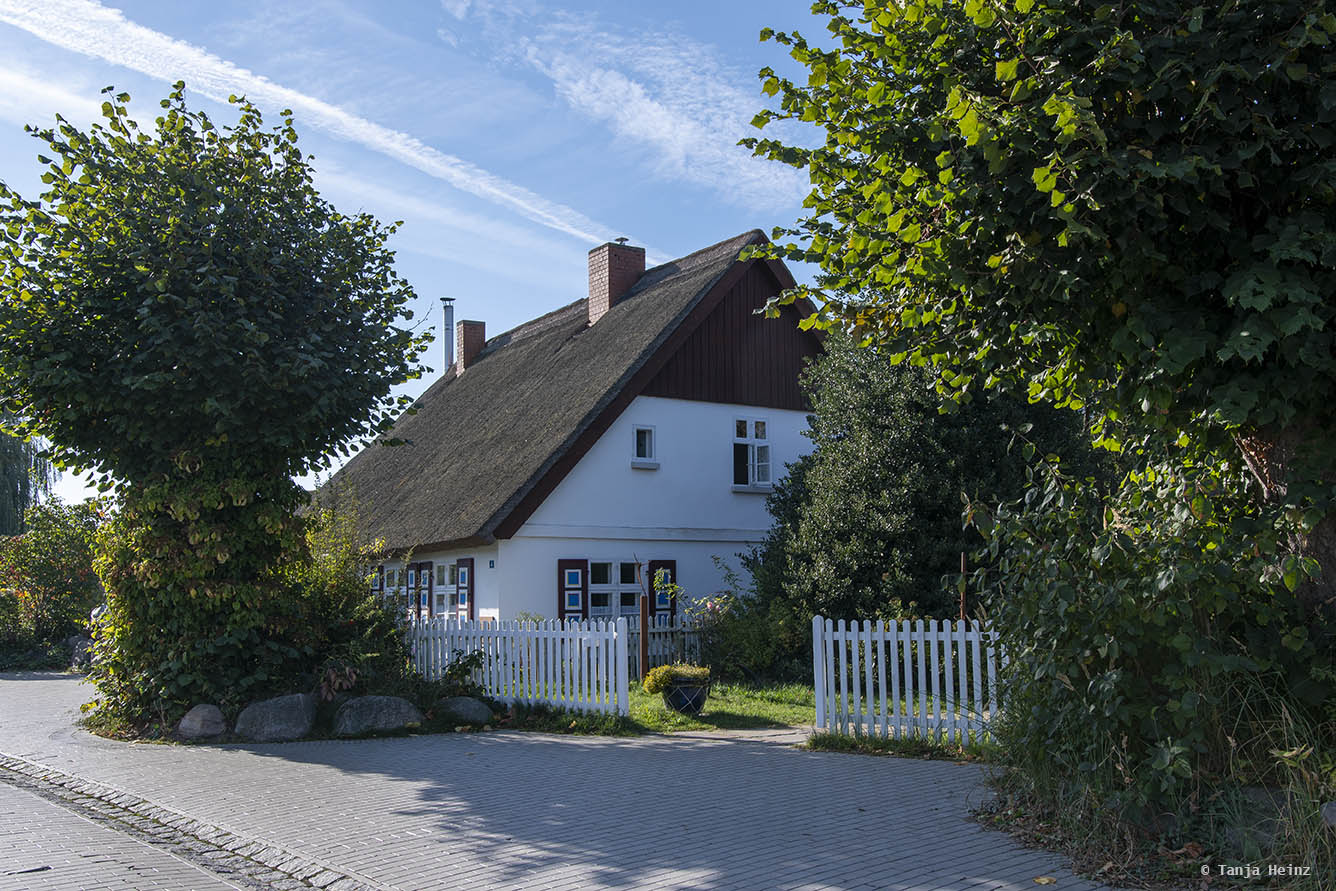
If you want to take a rest, why not drink a hot Sanddorn tea or Sanddorn juice?
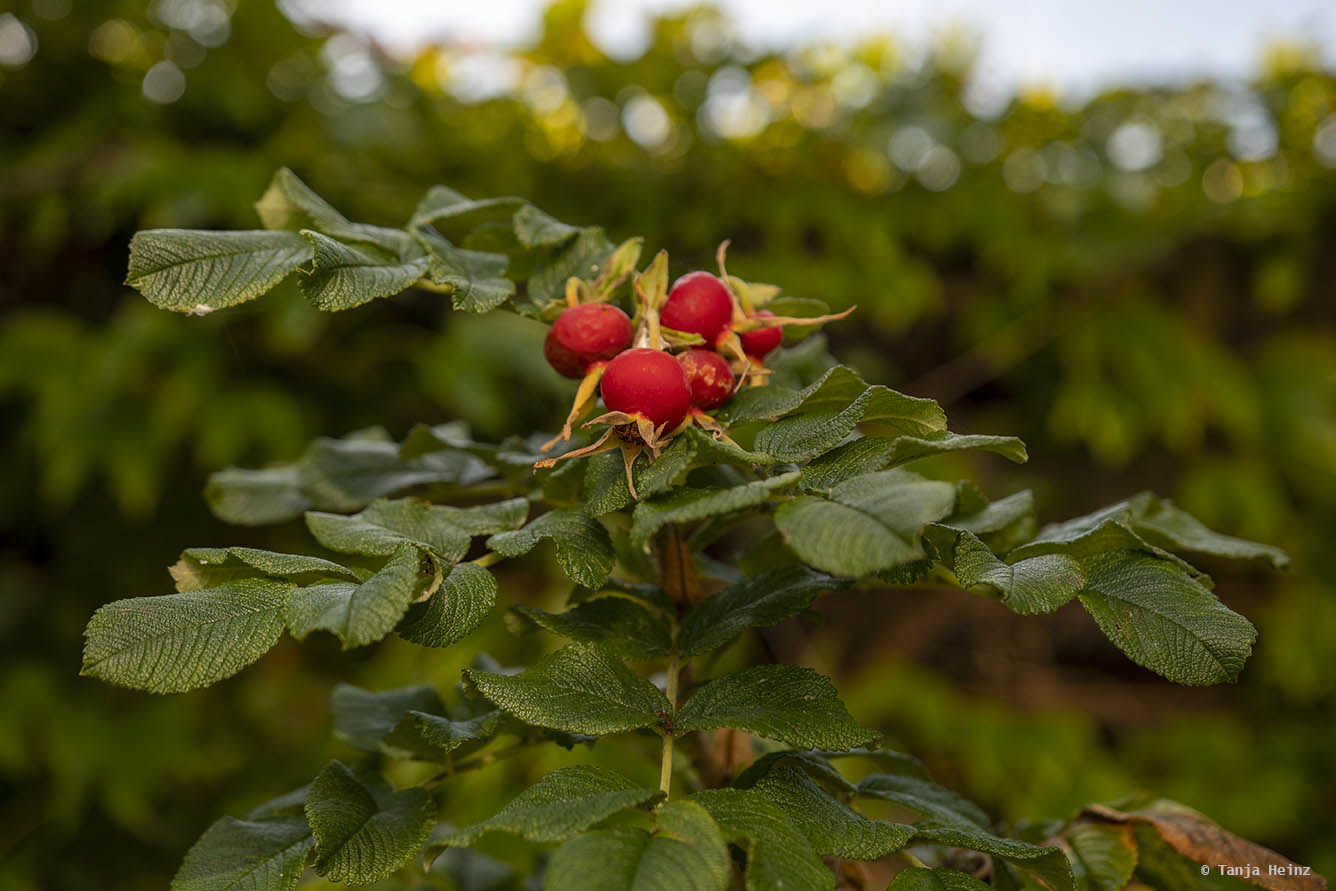
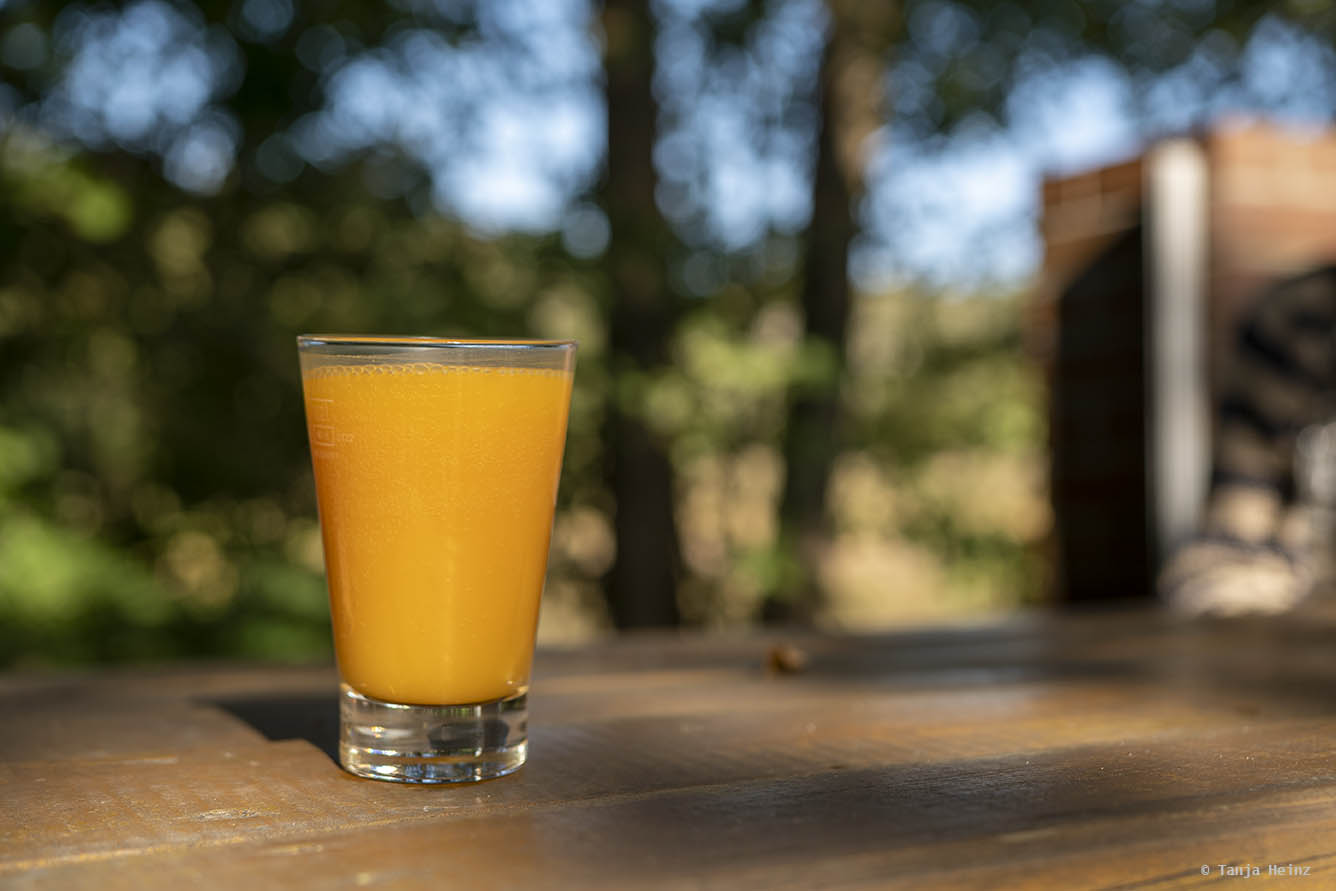
Although our focus were the common cranes on Fischland-Darß-Zingst, the peninsula has so much more to offer. We really enjoyed three wonderful days there at the Baltic See.
Practical information
How to get to Fischland-Darß-Zingst
We arrived by public transport. We traveled from Berlin to Zingst with the bus company Flixbus. We paid 14,99 Euros for one ticket from Berlin to Zingst. For our return ticket we had to pay 29,99 Euro for one ticket. The journey between Berlin and Zingst takes about four hours and a half with the bus company Flixbus.
As it is so easy to get around by bike on Fischland-Darß-Zingst, I would travel again to Zingst by public transport. There are different bus stops on Fischland-Darß-Zingst. There are bus stops in Ahrenshoop, Born auf dem Darß, Dierhagen, Prerow, Wieck auf dem Darß, Wustrow, and Zingst.
If you want to rent a bike in Zingst, I can recommend Fahrradverleih Shop 8 in the street Strandstraße 19, 18374 Zingst. We paid 12 Euros for one day (which was actually a little bit more than 24 hours) for two bicycles.
Where to stay in Zingst
We stayed at the youth hostel DJH Jugendherberge Zingst. The youth hostel is located in the street Glebbe 57, 18374 Ostseeheilbad Zingst, and thus, close to the Flixbus bus stop in the street Jordanstraße 24, Max-Hünten-Weg, 18374 Zingst. Please check the prices of the youth hostel on the official website.
Crane observation by boat in Zingst
We booked a tour at the company Poschke. Between September and November the company offers tours specifically to observe common cranes around the island Große Kirr. We paid 15 Euros for one ticket with the MS River Star and the tour took more or less three hours. The company offers different boat tours between March and November. Please check the official website for more information about the tours, prices and the timetable.
More information about Fischland-Darß-Zingst and cranes
More information about the peninsula Fischland-Darß-Zingst:
Official website of the national park Western Pomerania Lagoon Area National Park (only in German)
Official website of the Ostseeheilbad Zingst (only in German)
Official website of the NATUREUM
Official website of Fischland-Darß-Zingst
Blog articles about common cranes on Fischland-Darß-Zingst:
Blog article written by Torsten on tberg.de (only in German)
Silvertravellers (only in German)
Nordziele (only in German)
Have you ever been on Fischland-Darß-Zingst? Or have you been at any other place at the Baltic Sea to observe common cranes? Let me know in the comments.
